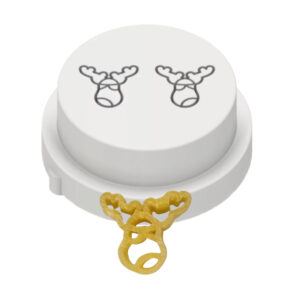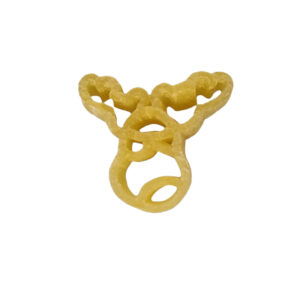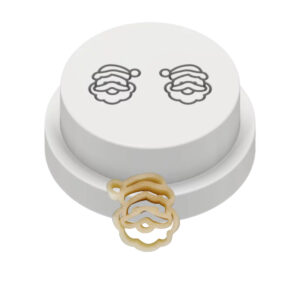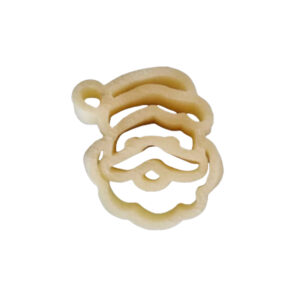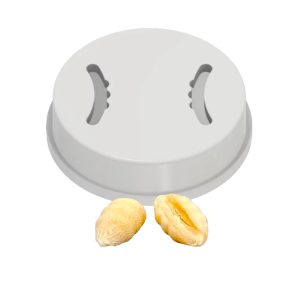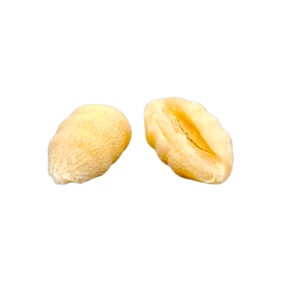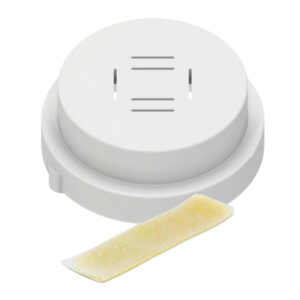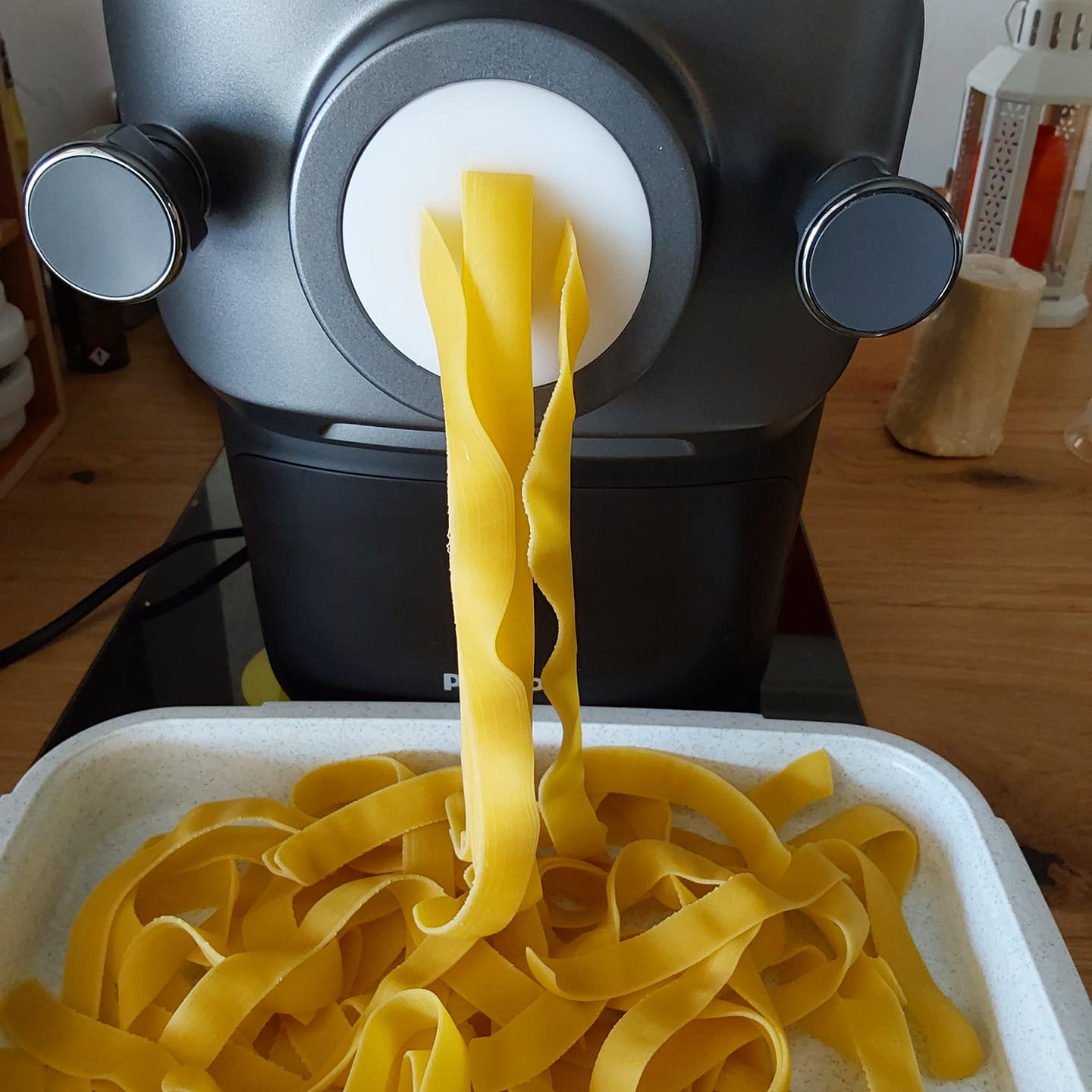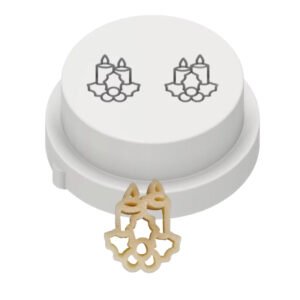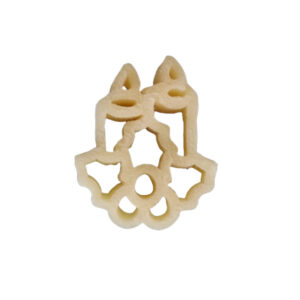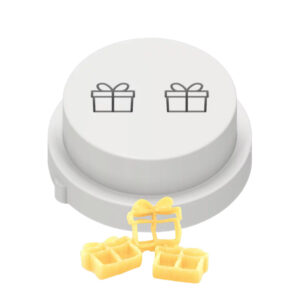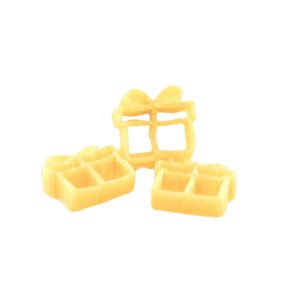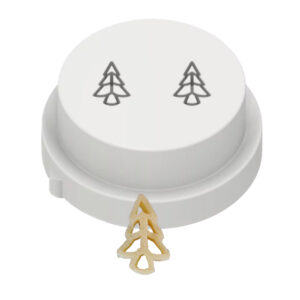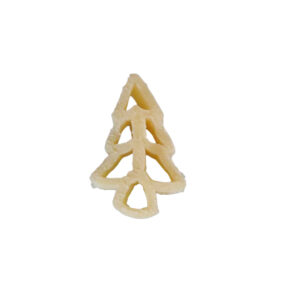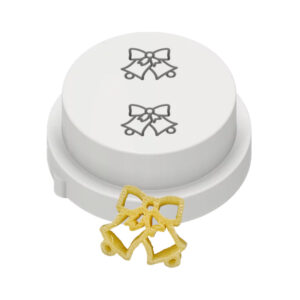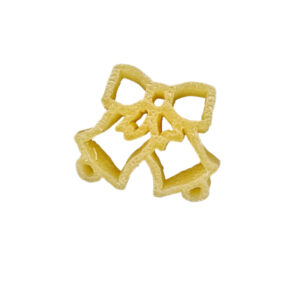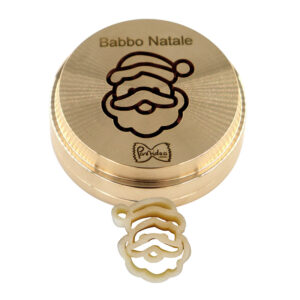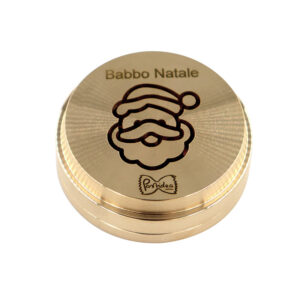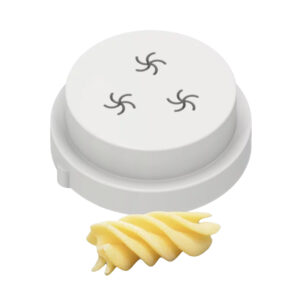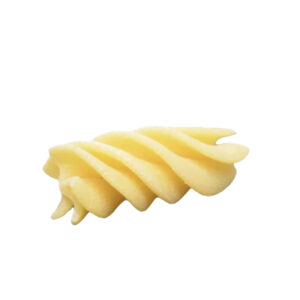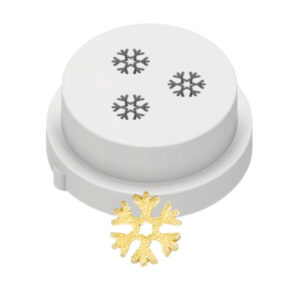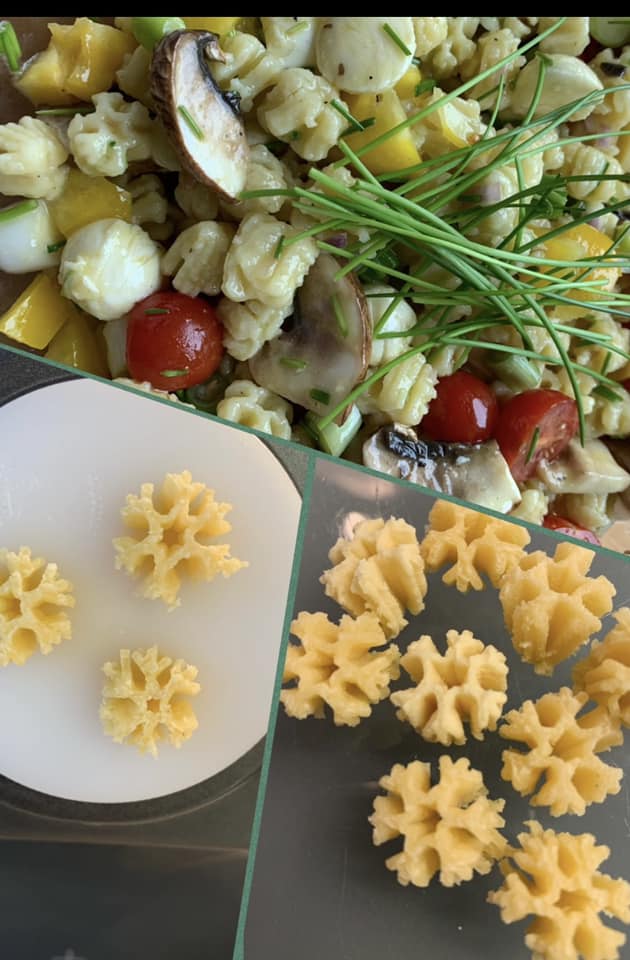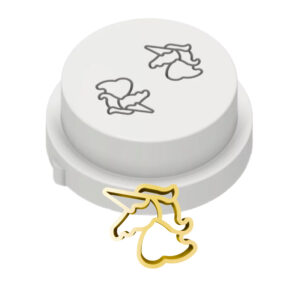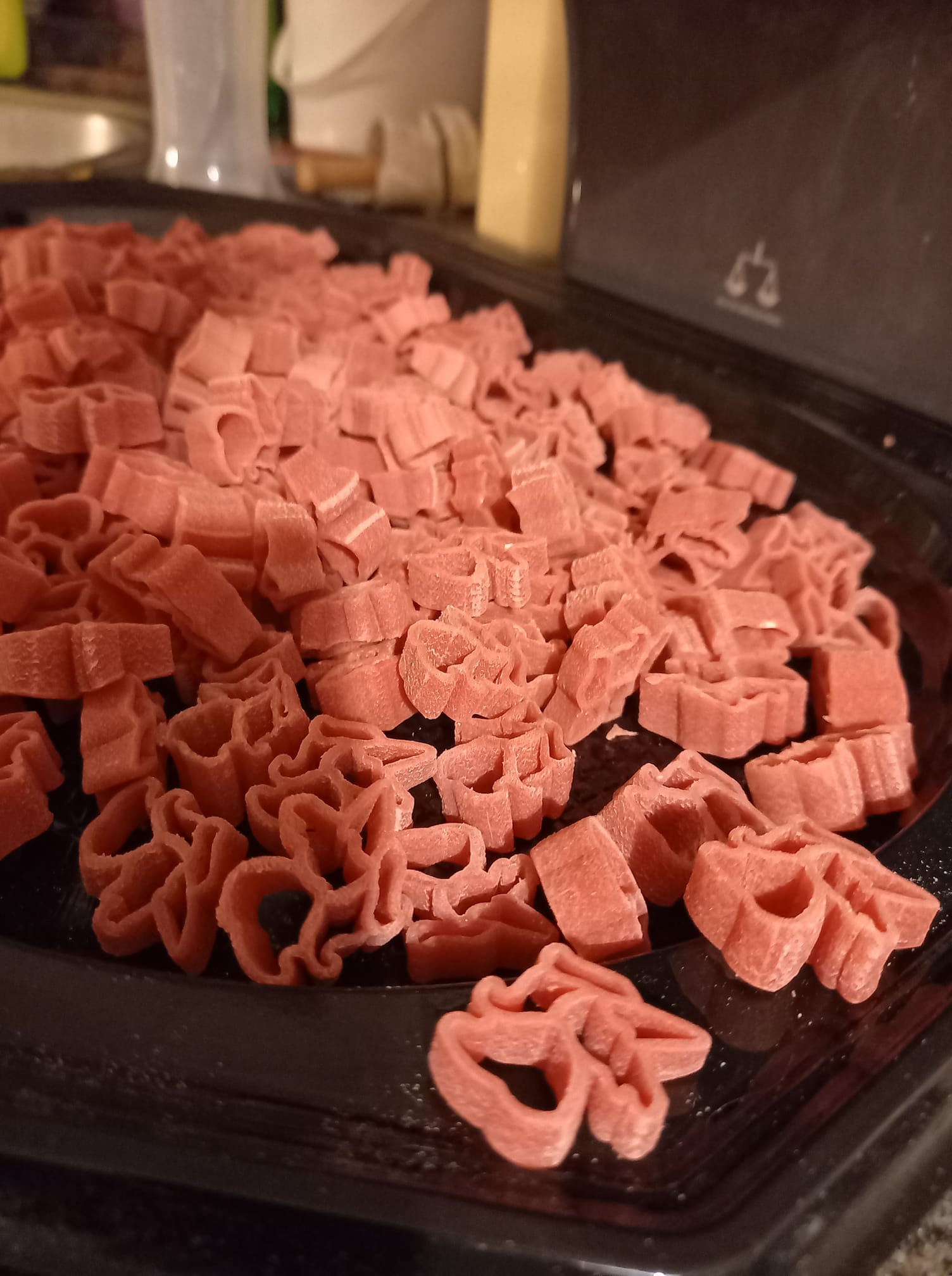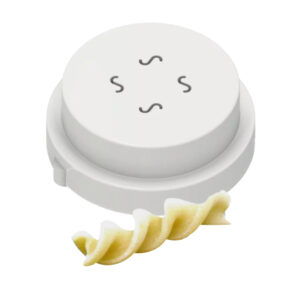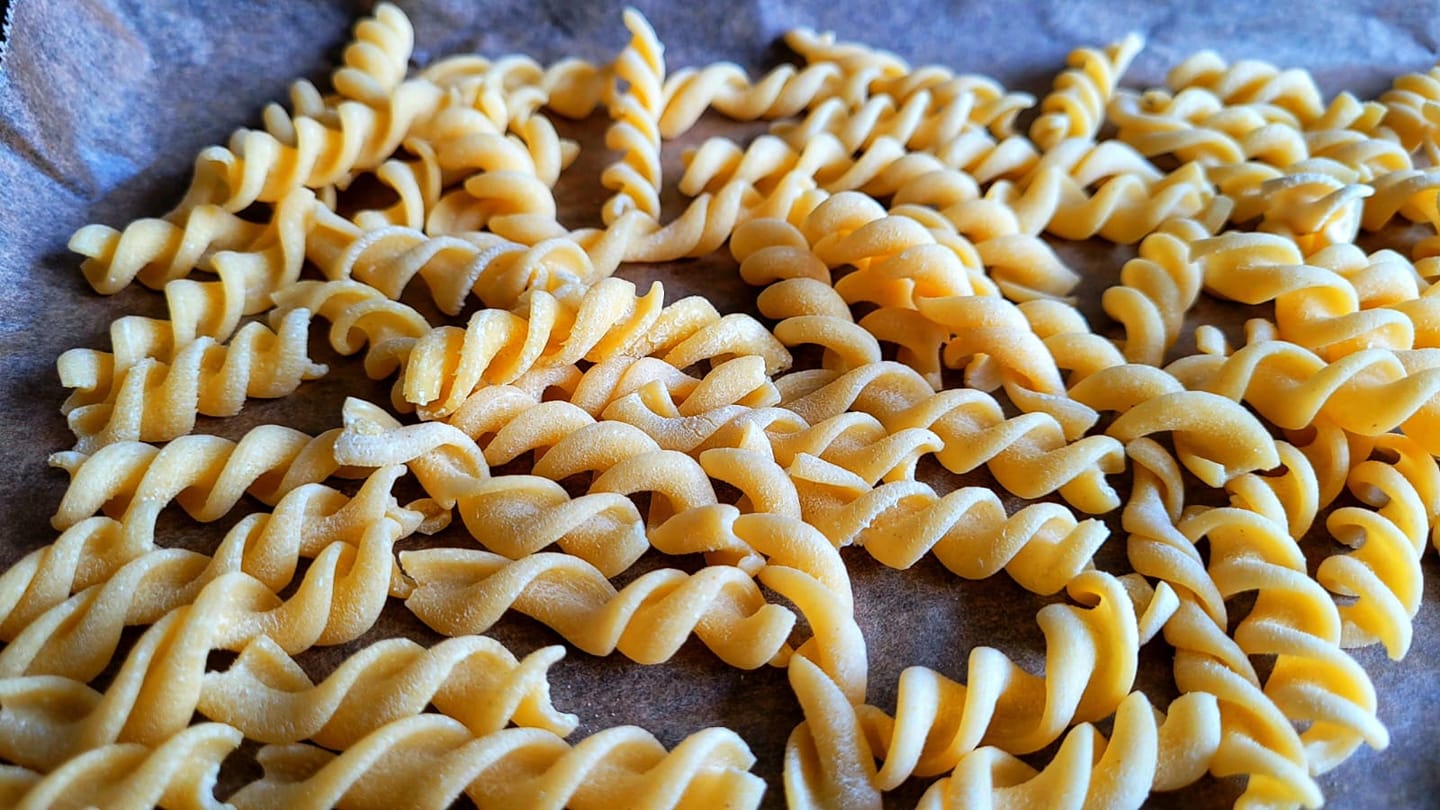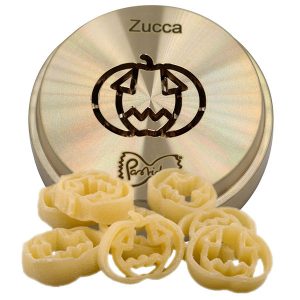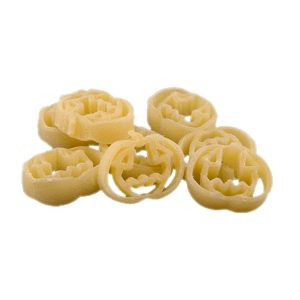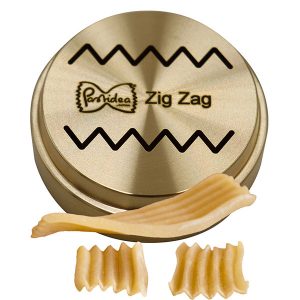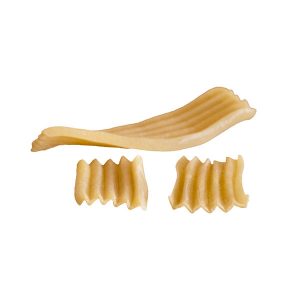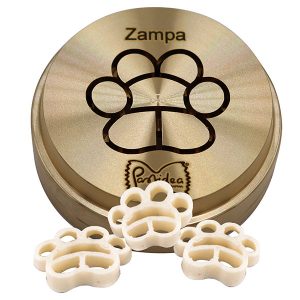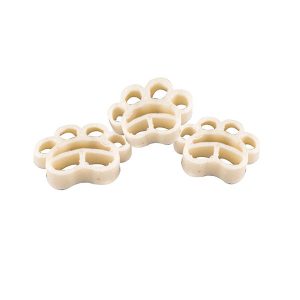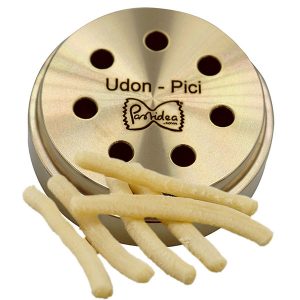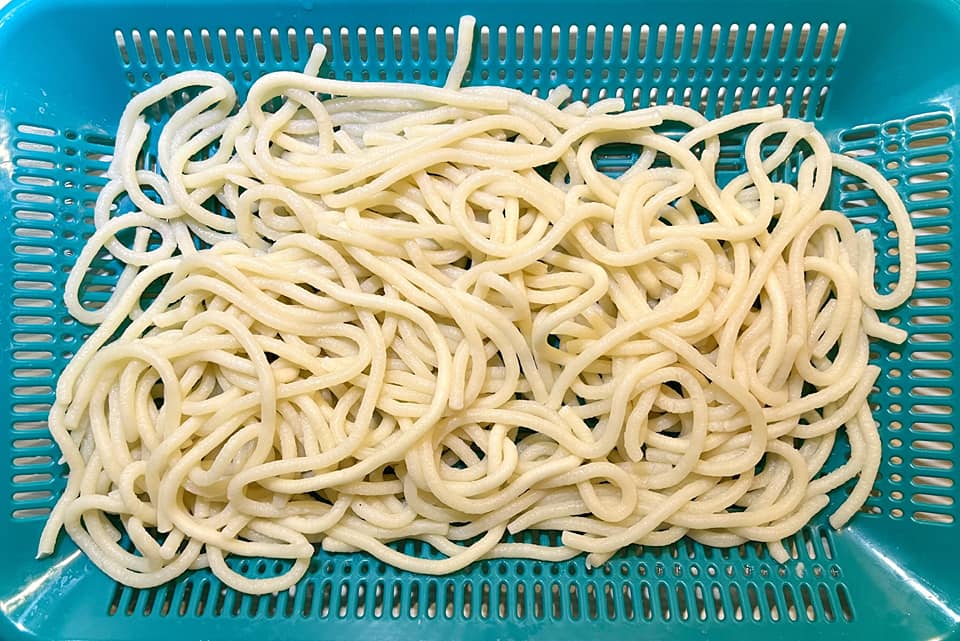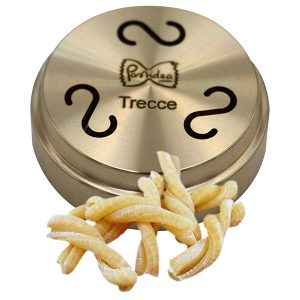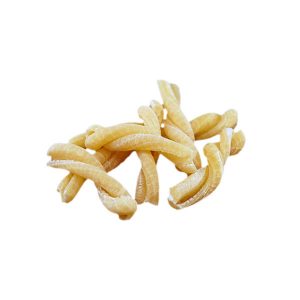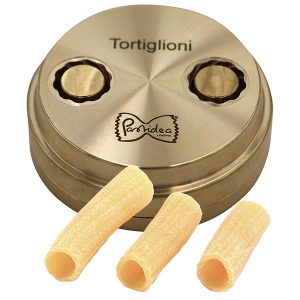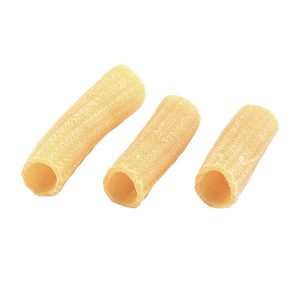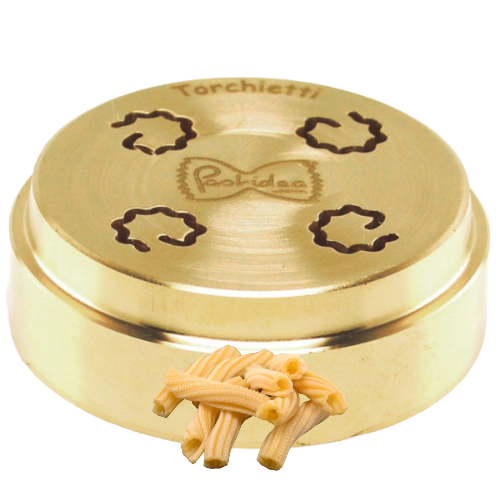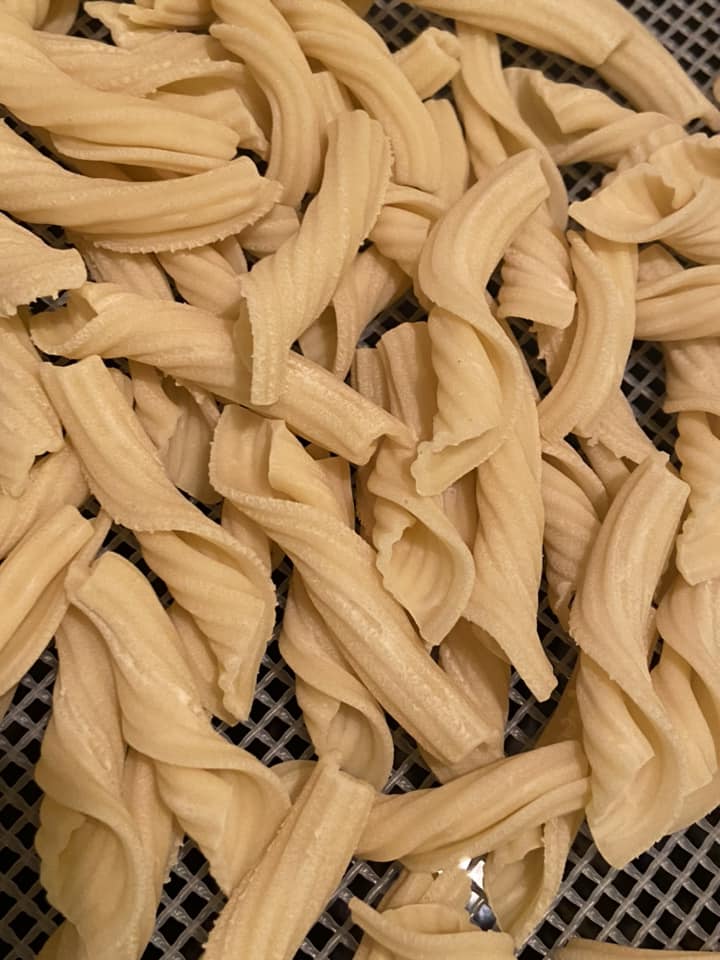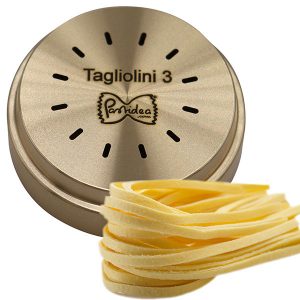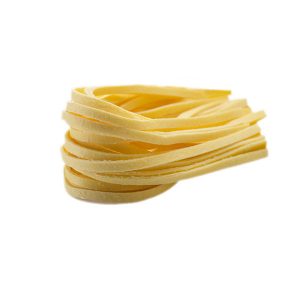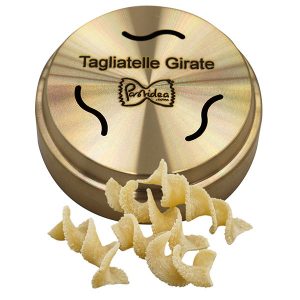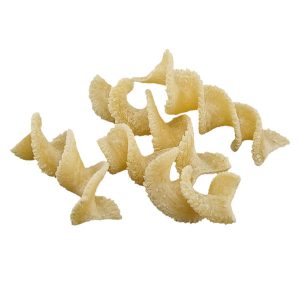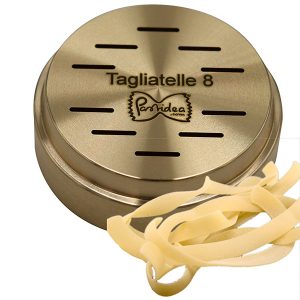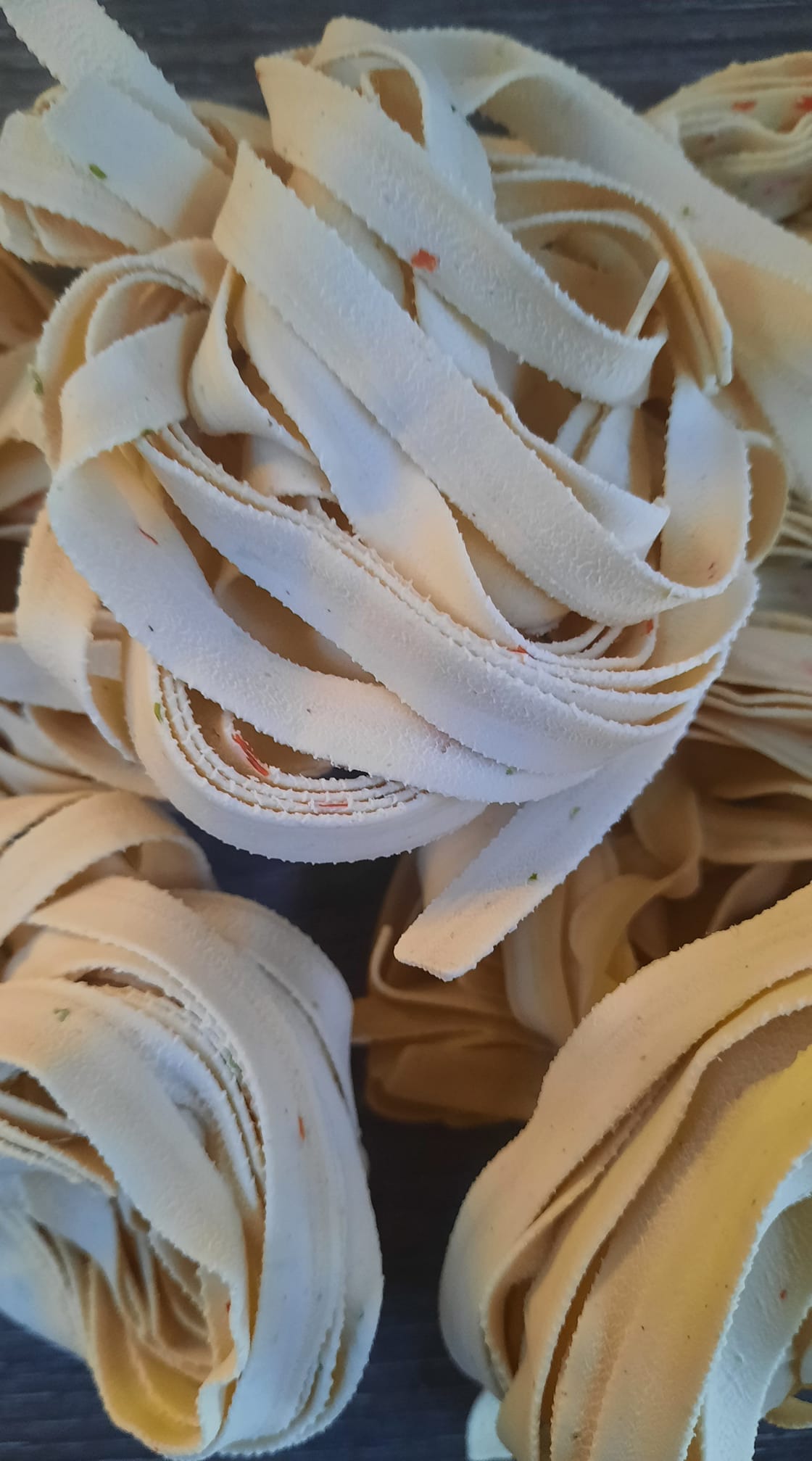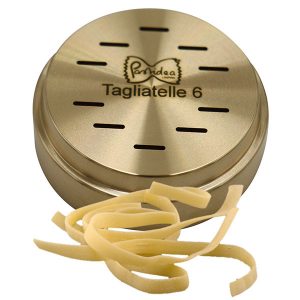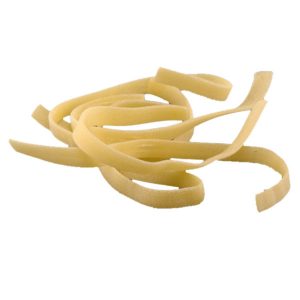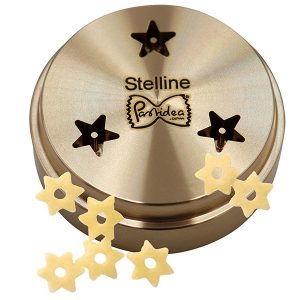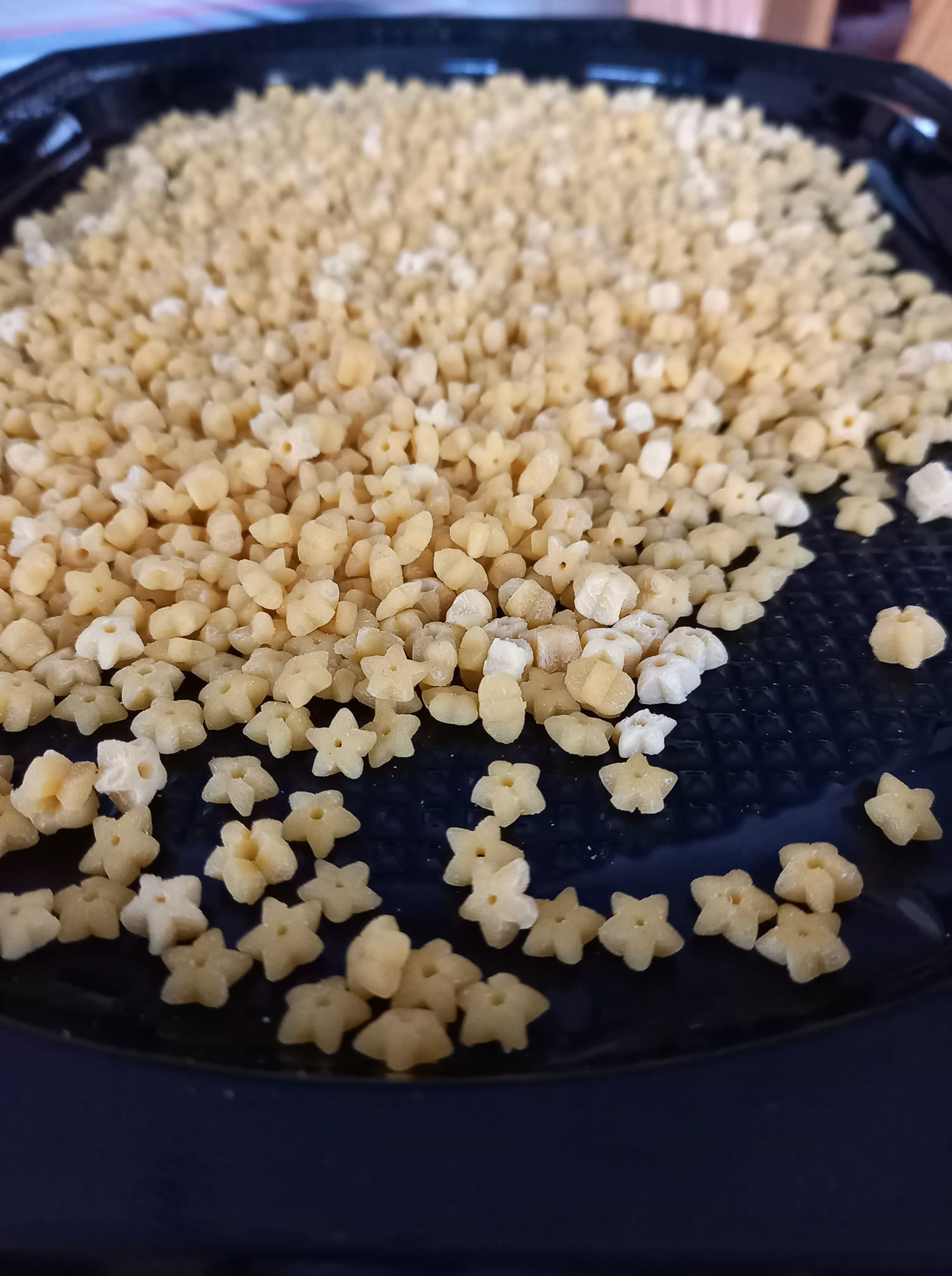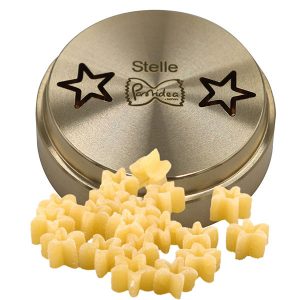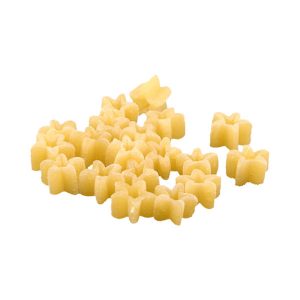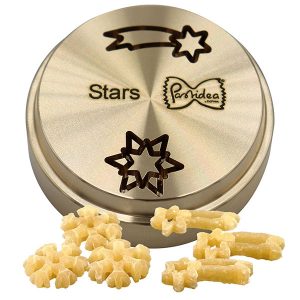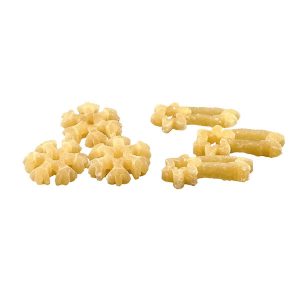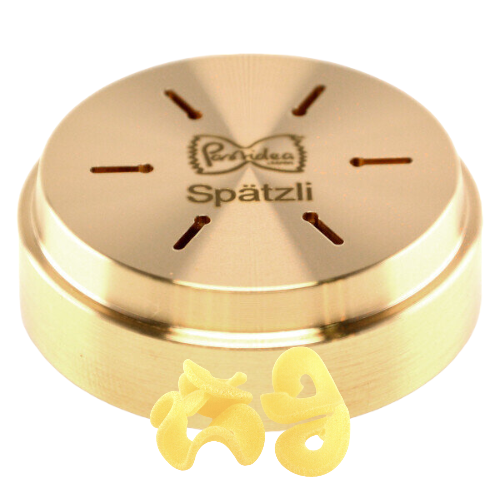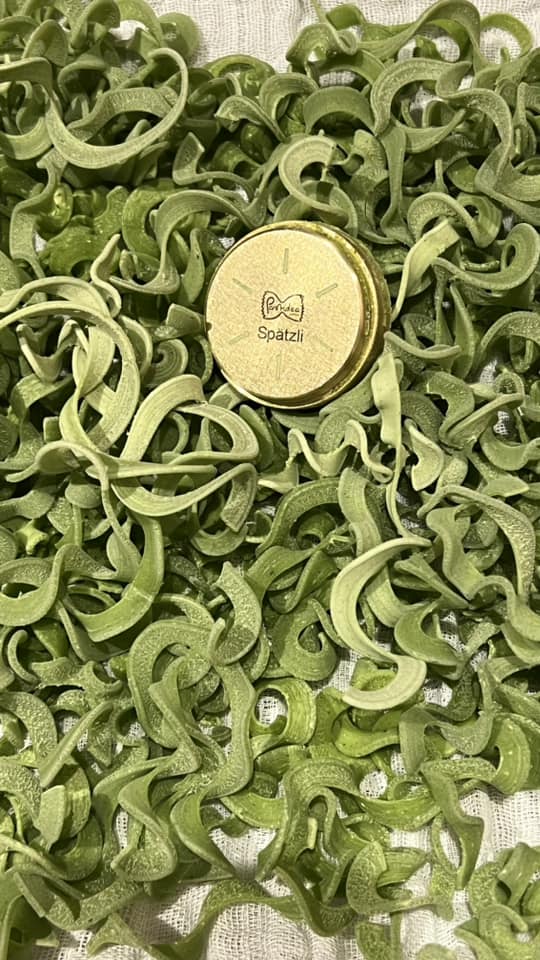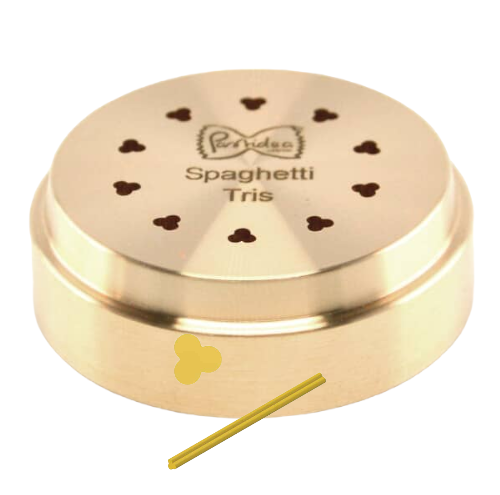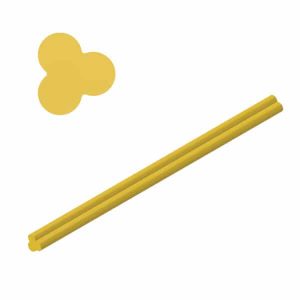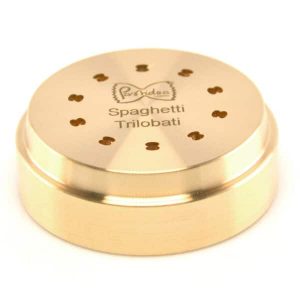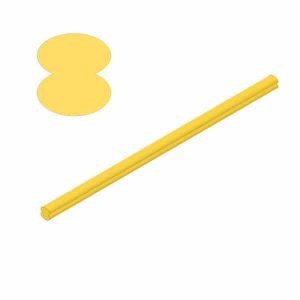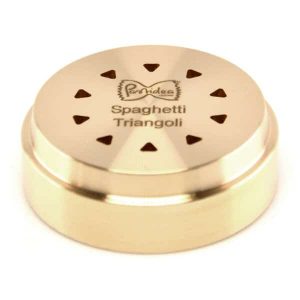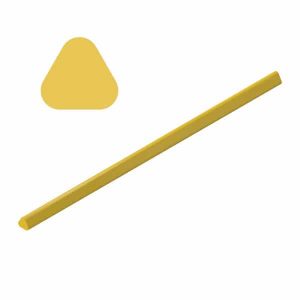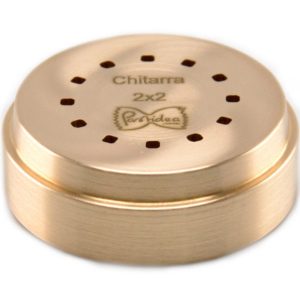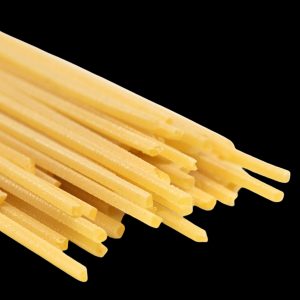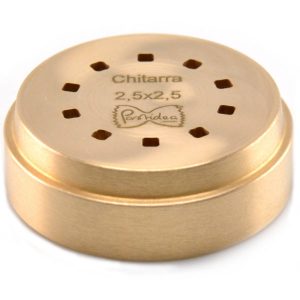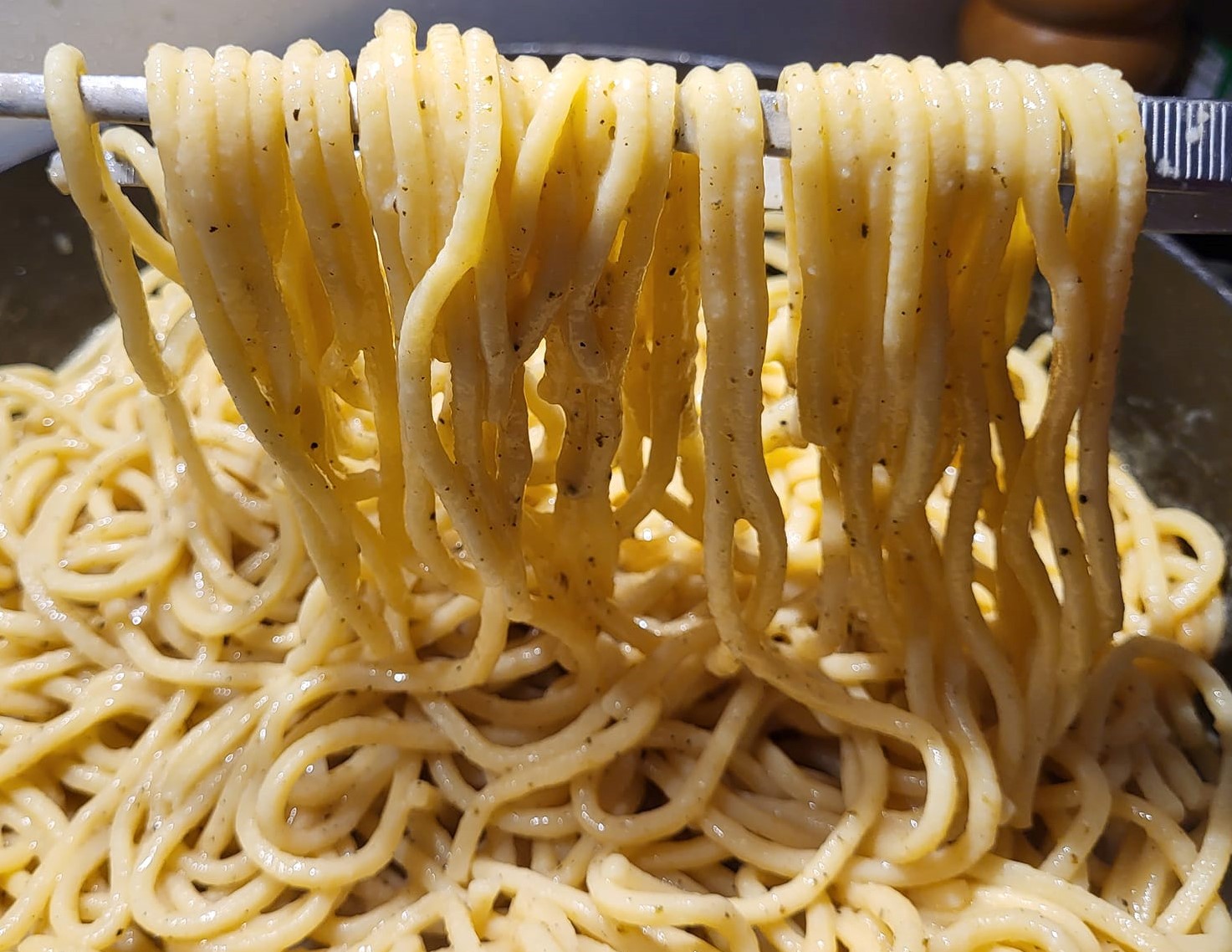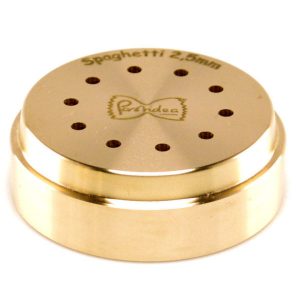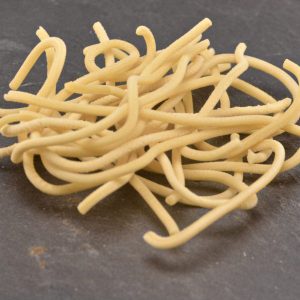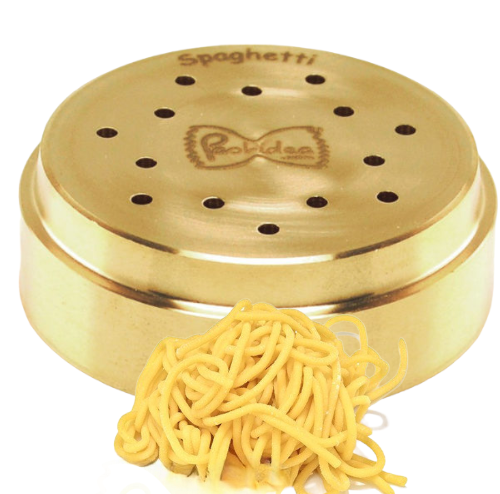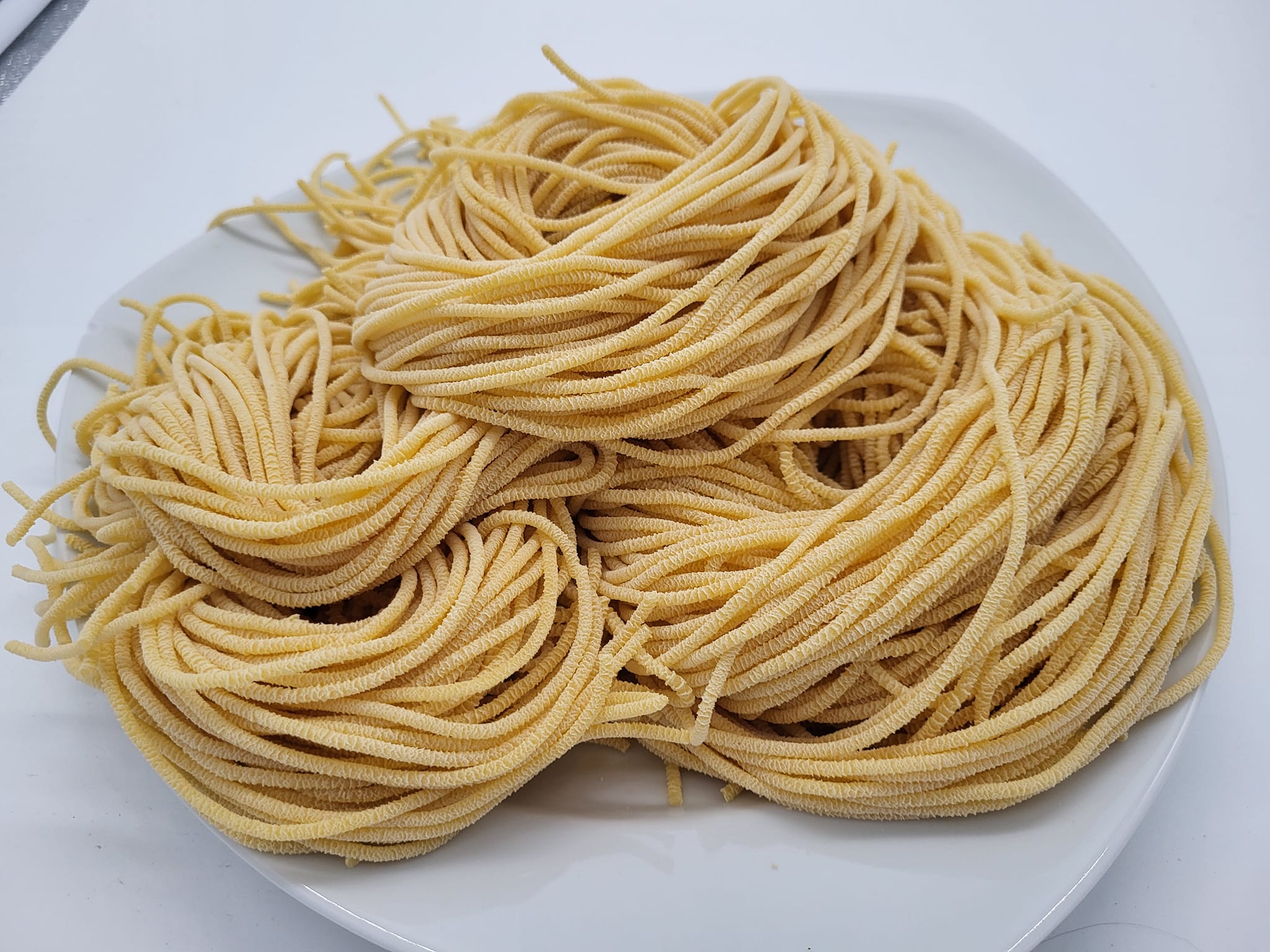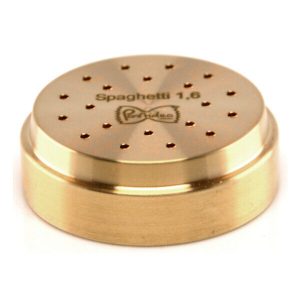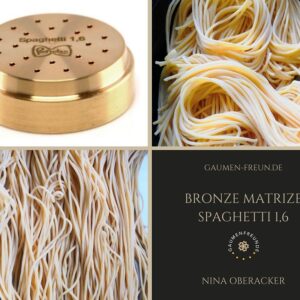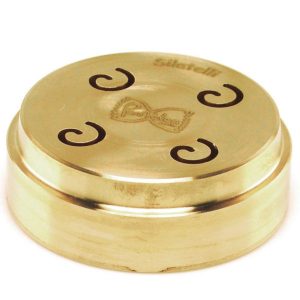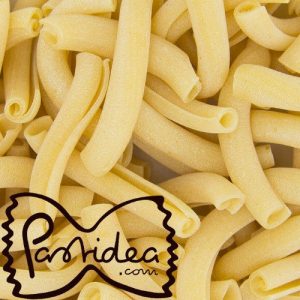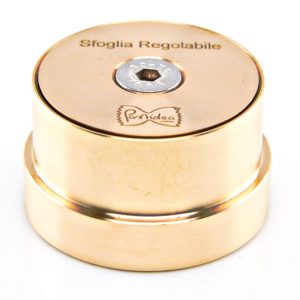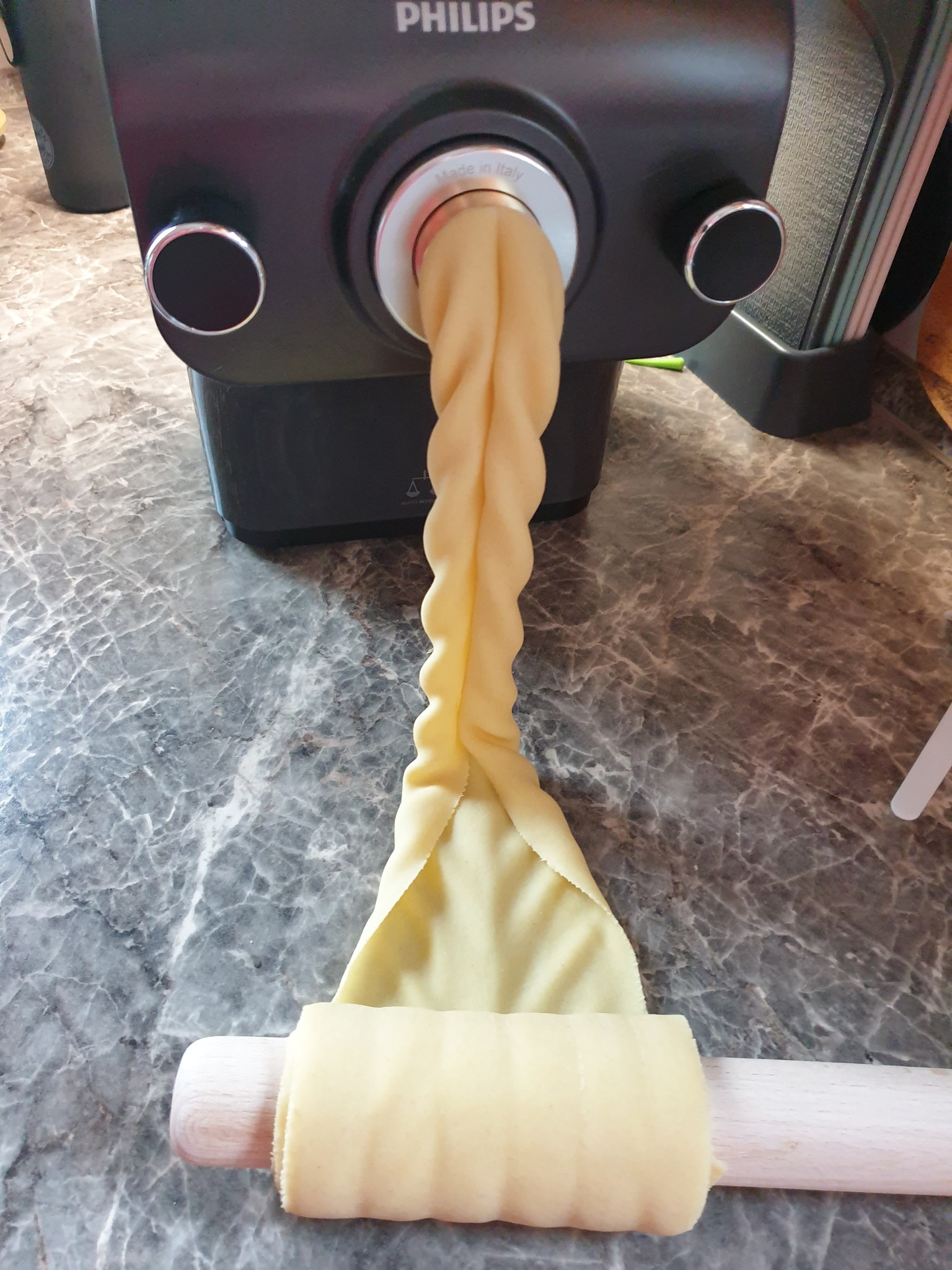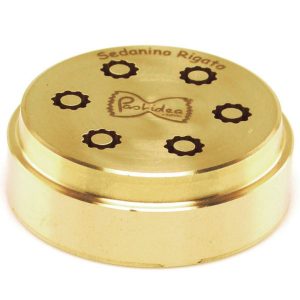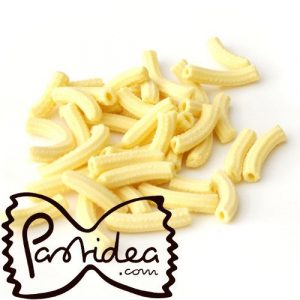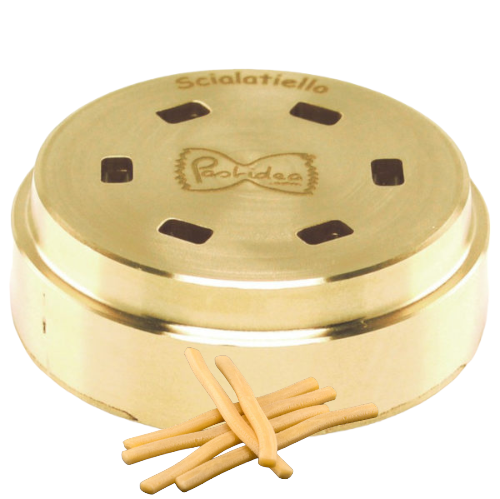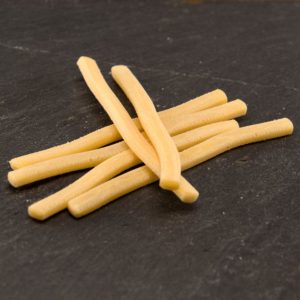20,90 € incl. VAT plus shipping costs
VAT included
excl. Shipping Rate
POM Reindeer die for Philips Avance. This motif matrix enchants young and old. Not just an eye-catcher at Christmas. Pasta insert made of POM (polyoxymethylene - guaranteed food-safe plastic) for use in Philips Pasta Maker Avance, Plus, Premium and the 7000 series. No adapter or similar is required. General information on compatibility and application The die is compatible with the following model numbers of the Philips Pasta Maker. The back two numbers can be any. HR2330/xx HR2331/xx HR2353/xx HR2354/xx HR2355/xx HR2356/xx HR2357/xx HR2358/xx HR2359/xx HR2365/xx HR2369/xx HR2375/xx HR2378/xx HR2380/xx HR2381/xx HR2382/xx HR2660/ xx HR2665/xx If you are unsure whether your model fits the dies, please send us a message, preferably with a photo of your pasta machine. We will respond to you promptly and tell you which matrices are right for you. POM is the abbreviation for polyoxymethylene, a guaranteed food-safe plastic. This is exactly the same material that is used in the Philips pasta maker matrices. POM has the advantage that it doesn't weigh much and you can put the matrices in the dishwasher for cleaning. Please note that the matrices are manufactured using micro milling. This is a complex process that enables delicate shapes. But small scratches from production and minor chips may be present, these are inevitable when using POM. It is always advisable to add a little more liquid than the pasta maker indicates and to only use cold liquids. The dough should be moist and crumbly. You can find a standard recipe for our matrices here. What else should you know? All of our matrices come from the Pastidea brand. Pastidea is an Italian company with years of experience in designing pasta matrices. Why an Italian company? Italians simply know the best about pasta and the like and know what to pay attention to. The design of a die is done by the Trafilaio, which translates to something like a die designer. A good Trafilaio knows exactly where on a die a little bit needs to be milled away so that the pasta has the right curve later. Maurizio of Pastidea has mastered this art par excellence. Immerse yourself in the world of your own pasta production with your palate friends. The taste of fresh homemade pasta is incomparably good.
20,90 € incl. VAT plus shipping costs
VAT included
excl. Shipping Rate
Die made of POM Santa Claus for Philips Avance. Pasta insert made of POM (polyoxymethylene - guaranteed food-safe plastic) for use in Philips Pasta Maker Avance, Plus, Premium and the 7000 series. No adapter or similar is required. General information on compatibility and application The die is compatible with the following model numbers of the Philips Pasta Maker. The back two numbers can be any. HR2330/xx HR2331/xx HR2353/xx HR2354/xx HR2355/xx HR2356/xx HR2357/xx HR2358/xx HR2359/xx HR2365/xx HR2369/xx HR2375/xx HR2378/xx HR2380/xx HR2381/xx HR2382/xx HR2660/ xx HR2665/xx If you are unsure whether your model fits the dies, please send us a message, preferably with a photo of your pasta machine. We will respond to you promptly and tell you which matrices are right for you. POM is the abbreviation for polyoxymethylene, a guaranteed food-safe plastic. This is exactly the same material that is used in the Philips pasta maker matrices. POM has the advantage that it doesn't weigh much and you can put the matrices in the dishwasher for cleaning. Please note that the matrices are manufactured using micro milling. This is a complex process that enables delicate shapes. But small scratches from production and minor chips may be present, these are inevitable when using POM. It is always advisable to add a little more liquid than the pasta maker indicates and to only use cold liquids. The dough should be moist and crumbly. You can find a standard recipe for our matrices here. What else should you know? All of our matrices come from the Pastidea brand. Pastidea is an Italian company with years of experience in designing pasta matrices. Why an Italian company? Italians simply know the best about pasta and the like and know what to pay attention to. The design of a die is done by the Trafilaio, which translates to something like a die designer. A good Trafilaio knows exactly where on a die a little bit needs to be milled away so that the pasta has the right curve later. Maurizio of Pastidea has mastered this art par excellence. Immerse yourself in the world of your own pasta production with your palate friends. The taste of fresh homemade pasta is incomparably good.
23,90 € incl. VAT plus shipping costs
VAT included
excl. Shipping Rate
POM Gnocchi potato gnocchi die for KitchenAid. Pasta insert for use in the KitchenAid tube pasta attachment and Marcato Regina. No adapter is required. This die shows how diverse a pasta machine can be. Gnocchi is not a pasta dish, but you can still prepare it easily with a matrix. Gnocchi are small dumplings made from potato dough. Every now and then you can also find variations with pumpkin, for example. The word gnocchi is pronounced NNjok-ki. Here you can clearly see the root of the Austrian word Nockerln. Note on the potato gnocchi matrix with recipe suggestion: The most important thing is not to use freshly harvested potatoes, but rather stored ones. It is best to cook floury potatoes, or alternatively mainly waxy ones, but not waxy potatoes. It is good to boil or steam the potatoes a day in advance and then store them in the refrigerator with their skins on. The potatoes lose moisture and the less moisture there is in the potatoes, the less flour you have to add later and the more intensely they taste like potatoes.Recipe: 800 gr. potatoes, boiled until floury, cooked a day before, chopped (e.g. with a meat grinder) 250 semola or flour or 125 gr. semola/flour and 125 gr. potato starch 100 gr. parmesan, very finely grated 4 egg yolks salt/pepper / Nutmeg Just mix the ingredients roughly, pour them into the tube attachment of the KitchenAid in portions and dispense. General information on compatibility and application Do you have a KitchenAid and a tube pasta attachment? Then these matrices fit directly. An adapter is not required. The die is compatible with the following model numbers of the tube attachment: 5KPEXTA, 5KSMPEXTA The dies also fit on the Marcato Regina and Pastamatic Ariete 1950 pasta machine. If you are unsure whether your model fits the dies, please send us a message, preferably with a Photo of your pasta machine. We will respond to you promptly and tell you which matrices are right for you. POM is the abbreviation for polyoxymethylene, a guaranteed food-safe plastic. This is exactly the same material that is used in the Philips pasta maker matrices. POM has the advantage that it doesn't weigh much and you can put the matrices in the dishwasher for cleaning. Please note that the matrices are manufactured using micro milling. This is a complex process that enables delicate shapes. But small scratches from production and minor chips may be present, these are inevitable when using POM. It is always advisable to add a little more liquid than your pasta machine indicates and to only use cold liquids. The dough should be moist and crumbly. You can find a standard recipe for our matrices here. What else should you know? It happens again and again that there are people who switch from the tube pasta attachment to the Philips Pastamaker Avance. In this case we have good news. You can continue to use this matrix and the other KA matrices in this section. All you need is a one-time adapter here find. Please note that this shape differs slightly from the diameter of the KitchenAid dies. This small change makes them more versatile.
20,90 € incl. VAT plus shipping costs
VAT included
excl. Shipping Rate
Die made of POM Pappardelle 15mm wide for Philips Avance. Pappardelle (ribbon noodles a la "wedding noodles") - isn't that a pretty name? I suspect the name comes from the Italian verb "pappare" - colloquially it means something like "to feed". Makes some sense too. I can never get enough of pappardelle and I devour it. Pappardelle are ultimately nothing more than tagliatelle, with the only difference being that they are much wider. While tagliatelle are usually between 6 and 8 mm wide, if they are a little over 1 cm wide they can be called pappardelle. Originally, these noodles were always prepared with eggs. But as always: Whatever you like and taste good is allowed. Width: 15 mm Thickness: 1 mm Pasta insert made of POM (polyoxymethylene - guaranteed food-safe plastic) for use in Philips Pasta Maker Avance, Plus, Premium and the 7000 series. No adapter or similar is required. General information on compatibility and application The die is compatible with the following model numbers of the Philips Pasta Maker. The back two numbers can be any. HR2330/xx HR2331/xx HR2353/xx HR2354/xx HR2355/xx HR2356/xx HR2357/xx HR2358/xx HR2359/xx HR2365/xx HR2369/xx HR2375/xx HR2378/xx HR2380/xx HR2381/xx HR2382/xx HR2660/ xx HR2665/xx If you are unsure whether your model fits the dies, please send us a message, preferably with a photo of your pasta machine. We will respond to you promptly and tell you which matrices are right for you. POM is the abbreviation for polyoxymethylene, a guaranteed food-safe plastic. This is exactly the same material that is used in the Philips pasta maker matrices. POM has the advantage that it doesn't weigh much and you can put the matrices in the dishwasher for cleaning. Please note that the matrices are manufactured using micro milling. This is a complex process that enables delicate shapes. But small scratches from production and minor chips may be present, these are inevitable when using POM. It is always advisable to add a little more liquid than the pasta maker indicates and to only use cold liquids. The dough should be moist and crumbly. You can find a standard recipe for our matrices here. What else should you know? All of our matrices come from the Pastidea brand. Pastidea is an Italian company with years of experience in designing pasta matrices. Why an Italian company? Italians simply know the best about pasta and the like and know what to pay attention to. The design of a die is done by the Trafilaio, which translates to something like a die designer. A good Trafilaio knows exactly where on a die a little bit needs to be milled away so that the pasta has the right curve later. Maurizio of Pastidea has mastered this art par excellence. Immerse yourself in the world of your own pasta production with your palate friends. The taste of fresh homemade pasta is incomparably good. Pasta insert made of POM (polyoxymethylene - guaranteed food-safe plastic) for use in Philips Pasta Maker Avance, Plus and Premium. No adapter or similar is required.
20,90 € incl. VAT plus shipping costs
VAT included
excl. Shipping Rate
Matrix made of POM candles / Advent / Christmas for Philips Avance. Pasta insert made of POM (polyoxymethylene - guaranteed food-safe plastic) for use in Philips Pasta Maker Avance, Plus, Premium and the 7000 series. No adapter or similar is required. General information on compatibility and application The die is compatible with the following model numbers of the Philips Pasta Maker. The back two numbers can be any. HR2330/xx HR2331/xx HR2353/xx HR2354/xx HR2355/xx HR2356/xx HR2357/xx HR2358/xx HR2359/xx HR2365/xx HR2369/xx HR2375/xx HR2378/xx HR2380/xx HR2381/xx HR2382/xx HR2660/ xx HR2665/xx If you are unsure whether your model fits the dies, please send us a message, preferably with a photo of your pasta machine. We will respond to you promptly and tell you which matrices are right for you. POM is the abbreviation for polyoxymethylene, a guaranteed food-safe plastic. This is exactly the same material that is used in the Philips pasta maker matrices. POM has the advantage that it doesn't weigh much and you can put the matrices in the dishwasher for cleaning. Please note that the matrices are manufactured using micro milling. This is a complex process that enables delicate shapes. But small scratches from production and minor chips may be present, these are inevitable when using POM. It is always advisable to add a little more liquid than the pasta maker indicates and to only use cold liquids. The dough should be moist and crumbly. You can find a standard recipe for our matrices here. What else should you know? All of our matrices come from the Pastidea brand. Pastidea is an Italian company with years of experience in designing pasta matrices. Why an Italian company? Italians simply know the best about pasta and the like and know what to pay attention to. The design of a die is done by the Trafilaio, which translates to something like a die designer. A good Trafilaio knows exactly where on a die a little bit needs to be milled away so that the pasta has the right curve later. Maurizio of Pastidea has mastered this art par excellence. Immerse yourself in the world of your own pasta production with your palate friends. The taste of fresh homemade pasta is incomparably good.
20,90 € incl. VAT plus shipping costs
VAT included
excl. Shipping Rate
Die made of POM gift/package/Christmas for Philips Avance. Whether for Christmas or a birthday, the die with the gift motif can be used all year round. Pasta insert made of POM (polyoxymethylene - guaranteed food-safe plastic) for use in Philips Pasta Maker Avance, Plus, Premium and the 7000 series. No adapter or similar is required. General information on compatibility and application The die is compatible with the following model numbers of the Philips Pasta Maker. The back two numbers can be any. HR2330/xx HR2331/xx HR2353/xx HR2354/xx HR2355/xx HR2356/xx HR2357/xx HR2358/xx HR2359/xx HR2365/xx HR2369/xx HR2375/xx HR2378/xx HR2380/xx HR2381/xx HR2382/xx HR2660/ xx HR2665/xx If you are unsure whether your model fits the dies, please send us a message, preferably with a photo of your pasta machine. We will respond to you promptly and tell you which matrices are right for you. POM is the abbreviation for polyoxymethylene, a guaranteed food-safe plastic. This is exactly the same material that is used in the Philips pasta maker matrices. POM has the advantage that it doesn't weigh much and you can put the matrices in the dishwasher for cleaning. Please note that the matrices are manufactured using micro milling. This is a complex process that enables delicate shapes. But small scratches from production and minor chips may be present, these are inevitable when using POM. It is always advisable to add a little more liquid than the pasta maker indicates and to only use cold liquids. The dough should be moist and crumbly. You can find a standard recipe for our matrices here. What else should you know? All of our matrices come from the Pastidea brand. Pastidea is an Italian company with years of experience in designing pasta matrices. Why an Italian company? Italians simply know the best about pasta and the like and know what to pay attention to. The design of a die is done by the Trafilaio, which translates to something like a die designer. A good Trafilaio knows exactly where on a die a little bit needs to be milled away so that the pasta has the right curve later. Maurizio of Pastidea has mastered this art par excellence. Immerse yourself in the world of your own pasta production with your palate friends. The taste of fresh homemade pasta is incomparably good.
20,90 € incl. VAT plus shipping costs
VAT included
excl. Shipping Rate
Die made of POM Christmas tree / Christmas tree / Christmas for Philips Avance. Pasta insert made of POM (polyoxymethylene - guaranteed food-safe plastic) for use in Philips Pasta Maker Avance, Plus, Premium and the 7000 series. No adapter or similar is required. General information on compatibility and application The die is compatible with the following model numbers of the Philips Pasta Maker. The back two numbers can be any. HR2330/xx HR2331/xx HR2353/xx HR2354/xx HR2355/xx HR2356/xx HR2357/xx HR2358/xx HR2359/xx HR2365/xx HR2369/xx HR2375/xx HR2378/xx HR2380/xx HR2381/xx HR2382/xx HR2660/ xx HR2665/xx If you are unsure whether your model fits the dies, please send us a message, preferably with a photo of your pasta machine. We will respond to you promptly and tell you which matrices are right for you. POM is the abbreviation for polyoxymethylene, a guaranteed food-safe plastic. This is exactly the same material that is used in the Philips pasta maker matrices. POM has the advantage that it doesn't weigh much and you can put the matrices in the dishwasher for cleaning. Please note that the matrices are manufactured using micro milling. This is a complex process that enables delicate shapes. But small scratches from production and minor chips may be present, these are inevitable when using POM. It is always advisable to add a little more liquid than the pasta maker indicates and to only use cold liquids. The dough should be moist and crumbly. You can find a standard recipe for our matrices here. What else should you know? All of our matrices come from the Pastidea brand. Pastidea is an Italian company with years of experience in designing pasta matrices. Why an Italian company? Italians simply know the best about pasta and the like and know what to pay attention to. The design of a die is done by the Trafilaio, which translates to something like a die designer. A good Trafilaio knows exactly where on a die a little bit needs to be milled away so that the pasta has the right curve later. Maurizio of Pastidea has mastered this art par excellence. Immerse yourself in the world of your own pasta production with your palate friends. The taste of fresh homemade pasta is incomparably good.
20,90 € incl. VAT plus shipping costs
VAT included
excl. Shipping Rate
Die made of POM bells / Christmas / bell for Philips Avance. Pasta insert made of POM (polyoxymethylene - guaranteed food-safe plastic) for use in Philips Pasta Maker Avance, Plus, Premium and the 7000 series. No adapter or similar is required. General information on compatibility and application The die is compatible with the following model numbers of the Philips Pasta Maker. The back two numbers can be any. HR2330/xx HR2331/xx HR2353/xx HR2354/xx HR2355/xx HR2356/xx HR2357/xx HR2358/xx HR2359/xx HR2365/xx HR2369/xx HR2375/xx HR2378/xx HR2380/xx HR2381/xx HR2382/xx HR2660/ xx HR2665/xx If you are unsure whether your model fits the dies, please send us a message, preferably with a photo of your pasta machine. We will respond to you promptly and tell you which matrices are right for you. POM is the abbreviation for polyoxymethylene, a guaranteed food-safe plastic. This is exactly the same material that is used in the Philips pasta maker matrices. POM has the advantage that it doesn't weigh much and you can put the matrices in the dishwasher for cleaning. Please note that the matrices are manufactured using micro milling. This is a complex process that enables delicate shapes. But small scratches from production and minor chips may be present, these are inevitable when using POM. It is always advisable to add a little more liquid than the pasta maker indicates and to only use cold liquids. The dough should be moist and crumbly. You can find a standard recipe for our matrices here. What else should you know? All of our matrices come from the Pastidea brand. Pastidea is an Italian company with years of experience in designing pasta matrices. Why an Italian company? Italians simply know the best about pasta and the like and know what to pay attention to. The design of a die is done by the Trafilaio, which translates to something like a die designer. A good Trafilaio knows exactly where on a die a little bit needs to be milled away so that the pasta has the right curve later. Maurizio of Pastidea has mastered this art par excellence. Immerse yourself in the world of your own pasta production with your palate friends. The taste of fresh homemade pasta is incomparably good.
35,60 € incl. VAT plus shipping costs
VAT included
excl. Shipping Rate
Bronze die Santa Claus Babbo Natale from Pastidea. Pasta insert for Kenwood AT910, AX910, KAX910ME, PP510, KAX92.AO, KAX91.A0ME. With an adapter, the die can be used in many other pasta machines, e.g. Philips Pastamaker Avance, Philips Viva, KitchenAid, Simac, Ariete, Unold, La Fattorina, Firmar, TR50, Häussler, Korngold, Omega. The die is delivered together with a transparent transport protection box. Why bronze: Bronze dies were the traditional way of making pasta. The pasta made “al bronzo” can only be found rarely and usually only in selected delicatessens. By pressing the pasta dough through the bronze matrices, the surface of the pasta is slightly roughened at the same time, making the pasta easier to grip. This allows the pasta to better absorb the sauce, flavors and spices later on. Would you like to learn more about bronze matrices? Then we recommend this article to you here. Recipe: It is recommended to use durum wheat semolina, enough cold liquid such as water and/or egg. The dough should be kneaded for about 8-10 minutes, this is the only way the gluten from the durum wheat can fully develop. The result should be a moist, crumbly dough. You can find a standard recipe for our matrices here. The matrices can also be used to produce gluten-free pasta. Sustainability: The format of the pastide matrices was originally designed for the Kenwood Pastafresca. By using reducing rings, the bronze matrices can be used on almost all other common pasta machines. All you need is an adapter that fits the machine. This means that even if over time the pasta machine is replaced by a different model due to a defect or for other reasons: the bronze die remains and can continue to be used in the future. Storage: Do you have several bronze matrices and are looking for storage to protect the matrix from dust and darkening caused by light? Then we recommend our storage systems to you here . Please note: Please note that the matrices may have small dark spots due to the material and production. This is due to the material and does not affect the function in any way. The matrices are not dishwasher safe. Should be dried immediately after cleaning to avoid water stains.
20,90 € incl. VAT plus shipping costs
VAT included
excl. Shipping Rate
Die made of POM Fusilli A5 13 mm for Philips Avance. One of the most famous noodles in Germany is fusilli. They are often called Spirelli, Rotini and rarely Eliche. The word fusilli comes from the Italian word “fuso”, which means spindle. In manual fusilli production, spaghetti is still wrapped around a spindle. According to legend, fusilli were invented at the court in Florence around 1550. The cook's son sat under the kitchen table and played with fallen pasta scraps that he wrapped around a knitting needle. These were the first fusillis. Not quite as clear, but much more likely, is the story that the Fusillis originated in southern Italy. At some point, spaghetti began to be rolled up in a spiral for drying, as this rotation made it much easier to dry and store. What is undisputed is that the twists mean that the sauce combines particularly well with the pasta. Fusillis are also rather uncomplicated pasta when it comes to drying and have little difficulty. Fusillis are available with 2, 3 or 5 wings. You can see how many propeller blades the Fusilli has by the die shape and also the die name. Ie a Fusilli A2 has two wings, an A3 has 3 wings, an A5 has 5 wings. Pasta insert made of POM (polyoxymethylene - guaranteed food-safe plastic) for use in Philips Pasta Maker Avance, Plus, Premium and the 7000 series. No adapter or similar is required. General information on compatibility and application The die is compatible with the following model numbers of the Philips Pasta Maker. The back two numbers can be any. HR2330/xx HR2331/xx HR2353/xx HR2354/xx HR2355/xx HR2356/xx HR2357/xx HR2358/xx HR2359/xx HR2365/xx HR2369/xx HR2375/xx HR2378/xx HR2380/xx HR2381/xx HR2382/xx HR2660/ xx HR2665/xx If you are unsure whether your model fits the dies, please send us a message, preferably with a photo of your pasta machine. We will respond to you promptly and tell you which matrices are right for you. POM is the abbreviation for polyoxymethylene, a guaranteed food-safe plastic. This is exactly the same material that is used in the Philips pasta maker matrices. POM has the advantage that it doesn't weigh much and you can put the matrices in the dishwasher for cleaning. Please note that the matrices are manufactured using micro milling. This is a complex process that enables delicate shapes. But small scratches from production and minor chips may be present, these are inevitable when using POM. It is always advisable to add a little more liquid than the pasta maker indicates and to only use cold liquids. The dough should be moist and crumbly. You can find a standard recipe for our matrices here. What else should you know? All of our matrices come from the Pastidea brand. Pastidea is an Italian company with years of experience in designing pasta matrices. Why an Italian company? Italians simply know the best about pasta and the like and know what to pay attention to. The design of a die is done by the Trafilaio, which translates to something like a die designer. A good Trafilaio knows exactly where on a die a little bit needs to be milled away so that the pasta has the right curve later. Maurizio of Pastidea has mastered this art par excellence. Immerse yourself in the world of your own pasta production with your palate friends. The taste of fresh homemade pasta is incomparably good.
20,90 € incl. VAT plus shipping costs
VAT included
excl. Shipping Rate
Die made of POM snowflake snowflakes for Philips Avance. Pasta insert made of POM (polyoxymethylene - guaranteed food-safe plastic) for use in Philips Pasta Maker Avance, Plus, Premium and the 7000 series. No adapter or similar is required. General information on compatibility and application The die is compatible with the following model numbers of the Philips Pasta Maker. The back two numbers can be any. HR2330/xx HR2331/xx HR2353/xx HR2354/xx HR2355/xx HR2356/xx HR2357/xx HR2358/xx HR2359/xx HR2365/xx HR2369/xx HR2375/xx HR2378/xx HR2380/xx HR2381/xx HR2382/xx HR2660/ xx HR2665/xx If you are unsure whether your model fits the dies, please send us a message, preferably with a photo of your pasta machine. We will respond to you promptly and tell you which matrices are right for you. POM is the abbreviation for polyoxymethylene, a guaranteed food-safe plastic. This is exactly the same material that is used in the Philips pasta maker matrices. POM has the advantage that it doesn't weigh much and you can put the matrices in the dishwasher for cleaning. Please note that the matrices are manufactured using micro milling. This is a complex process that enables delicate shapes. But small scratches from production and minor chips may be present, these are inevitable when using POM. It is always advisable to add a little more liquid than the pasta maker indicates and to only use cold liquids. The dough should be moist and crumbly. You can find a standard recipe for our matrices here. What else should you know? All of our matrices come from the Pastidea brand. Pastidea is an Italian company with years of experience in designing pasta matrices. Why an Italian company? Italians simply know the best about pasta and the like and know what to pay attention to. The design of a die is done by the Trafilaio, which translates to something like a die designer. A good Trafilaio knows exactly where on a die a little bit needs to be milled away so that the pasta has the right curve later. Maurizio of Pastidea has mastered this art par excellence. Immerse yourself in the world of your own pasta production with your palate friends. The taste of fresh homemade pasta is incomparably good.
20,90 € incl. VAT plus shipping costs
VAT included
excl. Shipping Rate
POM unicorn die for Philips Avance. Do you want to do something together with your children? Maybe with this motif matrix in which the mythical creature unicorn emerges from the Philips pasta maker? Pasta insert made of POM (polyoxymethylene - guaranteed food-safe plastic) for use in Philips Pasta Maker Avance, Plus, Premium and the 7000 series. No adapter or similar is required. General information on compatibility and application The die is compatible with the following model numbers of the Philips Pasta Maker. The back two numbers can be any. HR2330/xx HR2331/xx HR2353/xx HR2354/xx HR2355/xx HR2356/xx HR2357/xx HR2358/xx HR2359/xx HR2365/xx HR2369/xx HR2375/xx HR2378/xx HR2380/xx HR2381/xx HR2382/xx HR2660/ xx HR2665/xx If you are unsure whether your model fits the dies, please send us a message, preferably with a photo of your pasta machine. We will respond to you promptly and tell you which matrices are right for you. POM is the abbreviation for polyoxymethylene, a guaranteed food-safe plastic. This is exactly the same material that is used in the Philips pasta maker matrices. POM has the advantage that it doesn't weigh much and you can put the matrices in the dishwasher for cleaning. Please note that the matrices are manufactured using micro milling. This is a complex process that enables delicate shapes. But small scratches from production and minor chips may be present, these are inevitable when using POM. It is always advisable to add a little more liquid than the pasta maker indicates and to only use cold liquids. The dough should be moist and crumbly. You can find a standard recipe for our matrices here. What else should you know? All of our matrices come from the Pastidea brand. Pastidea is an Italian company with years of experience in designing pasta matrices. Why an Italian company? Italians simply know the best about pasta and the like and know what to pay attention to. The design of a die is done by the Trafilaio, which translates to something like a die designer. A good Trafilaio knows exactly where on a die a little bit needs to be milled away so that the pasta has the right curve later. Maurizio of Pastidea has mastered this art par excellence. Immerse yourself in the world of your own pasta production with your palate friends. The taste of fresh homemade pasta is incomparably good. Storage: Do you have several bronze matrices and are looking for storage to protect the matrix from dust and darkening caused by light? Then we recommend our storage systems to you here .
20,90 € incl. VAT plus shipping costs
VAT included
excl. Shipping Rate
Die made of POM Fusilli A2 8,5 mm for Philips Avance. One of the most famous noodles in Germany is fusilli. They are often called Spirelli, Rotini and rarely Eliche. The word fusilli comes from the Italian word “fuso”, which means spindle. In manual fusilli production, spaghetti is still wrapped around a spindle. According to legend, fusilli were invented at the court in Florence around 1550. The cook's son sat under the kitchen table and played with fallen pasta scraps that he wrapped around a knitting needle. These were the first fusillis. Not quite as clear, but much more likely, is the story that the Fusillis originated in southern Italy. At some point, spaghetti began to be rolled up in a spiral for drying, as this rotation made it much easier to dry and store. What is undisputed is that the twists mean that the sauce combines particularly well with the pasta. Fusillis are easy to dry. Fusillis are available with 2, 3 or 5 wings. You can see how many propeller blades the Fusilli has by the die shape and also the die name. Ie a Fusilli A2 has two wings, an A3 has 3 wings, an A5 has 5 wings. Pasta insert made of POM (polyoxymethylene - guaranteed food-safe plastic) for use in Philips Pasta Maker Avance, Plus, Premium and the 7000 series. No adapter or similar is required. General information on compatibility and application The die is compatible with the following model numbers of the Philips Pasta Maker. The back two numbers can be any. HR2330/xx HR2331/xx HR2353/xx HR2354/xx HR2355/xx HR2356/xx HR2357/xx HR2358/xx HR2359/xx HR2365/xx HR2369/xx HR2375/xx HR2378/xx HR2380/xx HR2381/xx HR2382/xx HR2660/ xx HR2665/xx If you are unsure whether your model fits the dies, please send us a message, preferably with a photo of your pasta machine. We will respond to you promptly and tell you which matrices are right for you. POM is the abbreviation for polyoxymethylene, a guaranteed food-safe plastic. This is exactly the same material that is used in the Philips pasta maker matrices. POM has the advantage that it doesn't weigh much and you can put the matrices in the dishwasher for cleaning. Please note that the matrices are manufactured using micro milling. This is a complex process that enables delicate shapes. But small scratches from production and minor chips may be present, these are inevitable when using POM. It is always advisable to add a little more liquid than the pasta maker indicates and to only use cold liquids. The dough should be moist and crumbly. You can find a standard recipe for our matrices here. What else should you know? All of our matrices come from the Pastidea brand. Pastidea is an Italian company with years of experience in designing pasta matrices. Why an Italian company? Italians simply know the best about pasta and the like and know what to pay attention to. The design of a die is done by the Trafilaio, which translates to something like a die designer. A good Trafilaio knows exactly where on a die a little bit needs to be milled away so that the pasta has the right curve later. Maurizio of Pastidea has mastered this art par excellence. Immerse yourself in the world of your own pasta production with your palate friends. The taste of fresh homemade pasta is incomparably good.
35,60 € incl. VAT plus shipping costs
VAT included
excl. Shipping Rate
Bronze die Zucca/Pumpkin Halloween. Motif matrix with a pumpkin, perfect for the Halloween party or a spooky dinner with the family. With an adapter, the die can be used in many other pasta machines, e.g. Philips Pastamaker Avance, Philips Viva, KitchenAid, Simac, Ariete, Unold, La Fattorina, Firmar, TR50, Häussler, Korngold, Omega Why bronze: Bronze matrices were the traditional way of making pasta. The pasta made “al bronzo” can only be found rarely and usually only in selected delicatessens. By pressing the pasta dough through the bronze dies, the surface of the pasta is slightly roughened and the pasta becomes more grippy. This allows the pasta to absorb the sauce, flavors and spices better later Recipe: It is recommended to use durum wheat semolina, sufficiently cold liquid such as water and/or egg. The dough should be kneaded for about 8-10 minutes so that the gluten from the durum wheat can fully develop. The result should be a moist, crumbly dough. We recommend the following standard recipe for our matrices: Ingredients: 250 g durum wheat semolina or Semola rimacinata Select ONE of the following ingredients: 100 ml cold water or 110 ml liquid consisting of two eggs, the rest of the water, lightly whisked Instructions: Please only use cold liquids . Avoid flour, replace it with semolina. Use binding agents such as xanthan gum, gluten, etc. only to a limited extent, a maximum of 1 teaspoon per 500 grams of dry ingredients. Otherwise the dough will be too firm and the dies could break. If you knead the dough for longer or let it rest, the gluten will develop on its own. You can recognize a good pasta dough by the fact that it is moist and crumbly. The production of gluten-free pasta is also possible with the matrices. Sustainability: The format of the Pastidea matrices was originally designed for the Kenwood Pastafresca. By using reducing rings, the bronze matrices can be used on almost all other common pasta machines. All you need is an adapter that fits the machine. This means that even if over time the pasta machine is replaced by a different model due to a defect or for other reasons: the bronze die remains and can continue to be used in the future. Storage: Do you have several bronze matrices and are you looking for storage to protect the matrix from dust and darkening due to the effects of light? Then we recommend our storage systems, which you can also find in our range. Please note: Please note that the matrices may have small dark spots due to the material and production. This is due to the material and does not affect the function in any way. The matrices are not dishwasher safe. Should be dried immediately after cleaning to avoid water stains.
32,90 € incl. VAT plus shipping costs
VAT included
excl. Shipping Rate
Bronze zigzag die. Pasta insert for Kenwood AT910, AX910, KAX910ME, PP510, KAX92.AO, KAX91.A0ME. With an adapter, the die can be used in many other pasta machines, e.g. Philips Pastamaker Avance, Philips Viva, KitchenAid, Simac, Ariete, Unold, La Fattorina, Firmar, TR50, Häussler, Korngold, Omega. The die is delivered together with a transparent transport protection box. Why bronze: Bronze dies were the traditional way of making pasta. The pasta made “al bronzo” can only be found rarely and usually only in selected delicatessens. By pressing the pasta dough through the bronze matrices, the surface of the pasta is slightly roughened at the same time, making the pasta easier to grip. This allows the pasta to better absorb the sauce, flavors and spices later on. Would you like to learn more about bronze matrices? Then we recommend this article to you here. Recipe: It is recommended to use durum wheat semolina, enough cold liquid such as water and/or egg. The dough should be kneaded for about 8-10 minutes, this is the only way the gluten from the durum wheat can fully develop. The result should be a moist, crumbly dough. You can find a standard recipe for our matrices here. The matrices can also be used to produce gluten-free pasta. Sustainability: The format of the Pastidea matrices was originally designed for the Kenwood Pastafresca. By using reducing rings, the bronze matrices can be used on almost all other common pasta machines. All you need is an adapter that fits the machine. This means that even if over time the pasta machine is replaced by a different model due to a defect or for other reasons: the bronze die remains and can continue to be used in the future. Storage: Do you have several bronze matrices and are you looking for storage to protect the matrix from dust and darkening due to the effects of light? Then we recommend our storage systems, which you can also find in our range. Please note: Please note that the matrices may have small dark spots due to the material and production. This is due to the material and does not affect the function in any way. The matrices are not dishwasher safe. Should be dried immediately after cleaning to avoid water stains.
35,60 € incl. VAT plus shipping costs
VAT included
excl. Shipping Rate
Zampa Paw Bronze Die
Pasta insert for Kenwood AT910, AX910, KAX910ME, PP510, KAX92.AO, KAX91.A0ME. With an adapter, the die can be used in many other pasta machines, e.g. Philips Pastamaker Avance, Philips Viva, KitchenAid, Simac, Ariete, Unold, La Fattorina, Firmar, TR50, Häussler, Korngold, Omega. The die is delivered together with a transparent transport protection box. Why bronze: Bronze matrices were the traditional way of making pasta. The pasta made “al bronzo” can only be found rarely and usually only in selected delicatessens. By pressing the pasta dough through the bronze dies, the surface of the pasta is slightly roughened and the pasta becomes more grippy. This allows the pasta to absorb the sauce, flavors and spices better later Recipe: It is recommended to use durum wheat semolina, sufficiently cold liquid such as water and/or egg. The dough should be kneaded for about 8-10 minutes so that the gluten from the durum wheat can fully develop. The result should be a moist, crumbly dough. We recommend the following standard recipe for our matrices: Ingredients: 250 g durum wheat semolina or Semola rimacinata Select ONE of the following ingredients: 100 ml cold water or 110 ml liquid consisting of two eggs, the rest of the water, lightly whisked Instructions: Please only use cold liquids . Avoid flour, replace it with semolina. Use binding agents such as xanthan gum, gluten, etc. only to a limited extent, a maximum of 1 teaspoon per 500 grams of dry ingredients. Otherwise the dough will be too firm and the dies could break. If you knead the dough for longer or let it rest, the gluten will develop on its own. You can recognize a good pasta dough by the fact that it is moist and crumbly. The production of gluten-free pasta is also possible with the matrices. Sustainability: The format of the Pastidea matrices was originally designed for the Kenwood Pastafresca. By using reducing rings, the bronze matrices can be used on almost all other common pasta machines. All you need is an adapter that fits the machine. This means that even if over time the pasta machine is replaced by a different model due to a defect or for other reasons: the bronze die remains and can continue to be used in the future. Storage: Do you have several bronze matrices and are you looking for storage to protect the matrix from dust and darkening due to the effects of light? Then we recommend our storage systems, which you can also find in our range. Please note: Please note that the matrices may have small dark spots due to the material and production. This is due to the material and does not affect the function in any way. The matrices are not dishwasher safe. Should be dried immediately after cleaning to avoid water stains.32,90 € incl. VAT plus shipping costs
VAT included
excl. Shipping Rate
Bronze die Udon / Pici 4 mm diameter. 1 die - 2 pasta formats: Udon and Pici Udon: Udon are noodles from Japanese cuisine that are prepared with water and flour. There are countless dishes to serve them. Some of them are eaten cold, some of them warm. The udon noodle is often eaten in a broth, together with vegetables and/or meat, often also tofu. Pici: Pici is probably the most famous type of pasta from Tuscany. These noodles are always eaten fresh. Many people also know the variety from Jamie Oliver; his Pici dishes have increased the popularity of Pici enormously in recent years. Since Pici used to be eaten primarily by farmers, emphasis was placed on the simplest ingredients. Only flour and water go into the dough. Eggs were already considered too precious. But there is also a type of pici, the lunghetti, in which eggs have always been used in the dough. Traditionally, each pici is rolled by hand. What kind of work. The die and the pasta maker really do a lot of the work for you. A classic sauce for pici is ragout of any kind. But sauces with breadcrumbs fried in oil in a pan are also often found. Simple ingredients - and as is often the case, simple can also be particularly delicious. Pasta insert for Kenwood AT910, AX910, KAX910ME, PP510, KAX92.AO, KAX91.A0ME. With an adapter, the die can be used in many other pasta machines, e.g. Philips Pastamaker Avance, Philips Viva, KitchenAid, Simac, Ariete, Unold, La Fattorina, Firmar, TR50, Häussler, Korngold, Omega. The die is delivered together with a transparent transport protection box. Why bronze: Bronze dies were the traditional way of making pasta. The pasta made “al bronzo” can only be found rarely and usually only in selected delicatessens. By pressing the pasta dough through the bronze matrices, the surface of the pasta is slightly roughened at the same time, making the pasta easier to grip. This allows the pasta to better absorb the sauce, flavors and spices later on. Would you like to learn more about bronze matrices? Then we recommend this article to you here. Recipe: It is recommended to use durum wheat semolina, enough cold liquid such as water and/or egg. The dough should be kneaded for about 8-10 minutes, this is the only way the gluten from the durum wheat can fully develop. The result should be a moist, crumbly dough. You can find a standard recipe for our matrices here. The matrices can also be used to produce gluten-free pasta. Sustainability: The format of the Pastidea matrices was originally designed for the Kenwood Pastafresca. By using reducing rings, the bronze matrices can be used on almost all other common pasta machines. All you need is an adapter that fits the machine. This means that even if over time the pasta machine is replaced by a different model due to a defect or for other reasons: the bronze die remains and can continue to be used in the future. Storage: Do you have several bronze matrices and are you looking for storage to protect the matrix from dust and darkening due to the effects of light? Then we recommend our storage systems, which you can also find in our range. Please note: Please note that the matrices may have small dark spots due to the material and production. This is due to the material and does not affect the function in any way. The matrices are not dishwasher safe. Should be dried immediately after cleaning to avoid water stains.
32,90 € incl. VAT plus shipping costs
VAT included
excl. Shipping Rate
Die of bronze braids / Trecce grande. Diameter: 13 mm Trecce (translated: braids) come from southern Italy and harmonize perfectly with sugo or pesto. They also look good with pasta salad or cream sauce. Due to their size, they run through the pasta machine particularly quickly. This means not only a beautiful format, but also one that allows you to quickly finish making pasta. Here in the bronze version: By pulling through bronze, the surface is slightly roughened, which means the sauce sticks better. Pasta insert for Kenwood AT910, AX910, KAX910ME, PP510, KAX92.AO, KAX91.A0ME. With an adapter, the die can be used in many other pasta machines, e.g. Philips Pastamaker Avance, Philips Viva, KitchenAid, Simac, Ariete, Unold, La Fattorina, Firmar, TR50, Häussler, Korngold, Omega. The die is delivered together with a transparent transport protection box. Why bronze: Bronze dies were the traditional way of making pasta. The pasta made “al bronzo” can only be found rarely and usually only in selected delicatessens. By pressing the pasta dough through the bronze matrices, the surface of the pasta is slightly roughened at the same time, making the pasta easier to grip. This allows the pasta to better absorb the sauce, flavors and spices later on. Would you like to learn more about bronze matrices? Then we recommend this article to you here. Recipe: It is recommended to use durum wheat semolina, enough cold liquid such as water and/or egg. The dough should be kneaded for about 8-10 minutes, this is the only way the gluten from the durum wheat can fully develop. The result should be a moist, crumbly dough. You can find a standard recipe for our matrices here. The matrices can also be used to produce gluten-free pasta. Sustainability: The format of the Pastidea matrices was originally designed for the Kenwood Pastafresca. By using reducing rings, the bronze matrices can be used on almost all other common pasta machines. All you need is an adapter that fits the machine. This means that even if over time the pasta machine is replaced by a different model due to a defect or for other reasons: the bronze die remains and can continue to be used in the future. Storage: Do you have several bronze matrices and are you looking for storage to protect the matrix from dust and darkening due to the effects of light? Then we recommend our storage systems, which you can also find in our range. Please note: Please note that the matrices may have small dark spots due to the material and production. This is due to the material and does not affect the function in any way. The matrices are not dishwasher safe. Should be dried immediately after cleaning to avoid water stains.
35,60 € incl. VAT plus shipping costs
VAT included
excl. Shipping Rate
Bronze Tortiglioni die. Diameter 12mm. Tortiglioni are one of the most famous types of pasta in Germany. Traditionally, tortiglioni come from Naples/southern Italy. Tortigliare means "twisted" in Italian and the -one at the end of the tortiglione indicates a larger noodle. This explains why the tortiglione is a relatively large tube pasta (larger than maccheroni, for example) in which the pasta grooves run slightly diagonally, i.e. twisted. This is also the difference to the closely related Rigatone: With the Rigatone the grooves run straight to the tube. Due to the combination: tube noodle, slight roughening due to bronze and the grooves, a lot of sauce gets stuck in this noodle. Pasta insert for Kenwood AT910, AX910, KAX910ME, PP510, KAX92.AO, KAX91.A0ME. With an adapter, the die can be used in many other pasta machines, e.g. Philips Pastamaker Avance, Philips Viva, KitchenAid, Simac, Ariete, Unold, La Fattorina, Firmar, TR50, Häussler, Korngold, Omega. The die is delivered together with a transparent transport protection box. Why bronze: Bronze dies were the traditional way of making pasta. The pasta made “al bronzo” can only be found rarely and usually only in selected delicatessens. By pressing the pasta dough through the bronze matrices, the surface of the pasta is slightly roughened at the same time, making the pasta easier to grip. This allows the pasta to better absorb the sauce, flavors and spices later on. Would you like to learn more about bronze matrices? Then we recommend this article to you here. Recipe: It is recommended to use durum wheat semolina, enough cold liquid such as water and/or egg. The dough should be kneaded for about 8-10 minutes, this is the only way the gluten from the durum wheat can fully develop. The result should be a moist, crumbly dough. You can find a standard recipe for our matrices here. The matrices can also be used to produce gluten-free pasta. Sustainability: The format of the Pastidea matrices was originally designed for the Kenwood Pastafresca. By using reducing rings, the bronze matrices can be used on almost all other common pasta machines. All you need is an adapter that fits the machine. This means that even if over time the pasta machine is replaced by a different model due to a defect or for other reasons: the bronze die remains and can continue to be used in the future. Storage: Do you have several bronze matrices and are you looking for storage to protect the matrix from dust and darkening due to the effects of light? Then we recommend our storage systems, which you can also find in our range. Please note: Please note that the matrices may have small dark spots due to the material and production. This is due to the material and does not affect the function in any way. The matrices are not dishwasher safe. Should be dried immediately after cleaning to avoid water stains.
32,90 € incl. VAT plus shipping costs
VAT included
excl. Shipping Rate
Torchietti are very thin-walled pasta with fine grooves. Pasta insert for Kenwood AT910, AX910, KAX910ME, PP510, KAX92.AO, KAX91.A0ME. With an adapter, the die can be used in many other pasta machines, e.g. Philips Pastamaker Avance, Philips Viva, KitchenAid, Simac, Ariete, Unold, La Fattorina, Firmar, TR50, Häussler, Korngold, Omega. The die is delivered together with a transparent transport protection box. Why bronze: Bronze dies were the traditional way of making pasta. The pasta made “al bronzo” can only be found rarely and usually only in selected delicatessens. By pressing the pasta dough through the bronze matrices, the surface of the pasta is slightly roughened at the same time, making the pasta easier to grip. This allows the pasta to better absorb the sauce, flavors and spices later on. Would you like to learn more about bronze matrices? Then we recommend this article to you here. Recipe: It is recommended to use durum wheat semolina, enough cold liquid such as water and/or egg. The dough should be kneaded for about 8-10 minutes, this is the only way the gluten from the durum wheat can fully develop. The result should be a moist, crumbly dough. You can find a standard recipe for our matrices here. The matrices can also be used to produce gluten-free pasta. Sustainability: The format of the Pastidea matrices was originally designed for the Kenwood Pastafresca. By using reducing rings, the bronze matrices can be used on almost all other common pasta machines. All you need is an adapter that fits the machine. This means that even if over time the pasta machine is replaced by a different model due to a defect or for other reasons: the bronze die remains and can continue to be used in the future. Storage: Do you have several bronze matrices and are you looking for storage to protect the matrix from dust and darkening due to the effects of light? Then we recommend our storage systems, which you can also find in our range. Please note: Please note that the matrices may have small dark spots due to the material and production. This is due to the material and does not affect the function in any way. The matrices are not dishwasher safe. Should be dried immediately after cleaning to avoid water stains.
32,90 € incl. VAT plus shipping costs
VAT included
excl. Shipping Rate
Die made of bronze Tagliolini 3 mm. Tagliolini are wafer-thin tagliatelle noodles. Wider than capellini but not as wide as tagliatelle. And because they are only 3 mm wide and only 1 mm thin, they are extremely delicate and leave a very nice, delicate mouthfeel when eaten. The name comes from the Italian verb "tagliare". Tagliare means "to cut" and the -ini at the end means that it is something small. So cut a strip of dough into many very small strips. This pasta shape is particularly widespread in the Italian regions of Molise, Piedmont and Emiglia-Romagna. But in Piedmont they have a different name, where they are mainly found under the name tajarin. The tagliolini are prepared with a dough made from durum wheat semolina and eggs. Pasta insert for Kenwood AT910, AX910, KAX910ME, PP510, KAX92.AO, KAX91.A0ME. With an adapter, the die can be used in many other pasta machines, e.g. Philips Pastamaker Avance, Philips Viva, KitchenAid, Simac, Ariete, Unold, La Fattorina, Firmar, TR50, Häussler, Korngold, Omega. The die is delivered together with a transparent transport protection box. Why bronze: Bronze dies were the traditional way of making pasta. The pasta made “al bronzo” can only be found rarely and usually only in selected delicatessens. By pressing the pasta dough through the bronze matrices, the surface of the pasta is slightly roughened at the same time, making the pasta easier to grip. This allows the pasta to better absorb the sauce, flavors and spices later on. Would you like to learn more about bronze matrices? Then we recommend this article to you here. Recipe: It is recommended to use durum wheat semolina, enough cold liquid such as water and/or egg. The dough should be kneaded for about 8-10 minutes, this is the only way the gluten from the durum wheat can fully develop. The result should be a moist, crumbly dough. You can find a standard recipe for our matrices here. The matrices can also be used to produce gluten-free pasta. Sustainability: The format of the Pastidea matrices was originally designed for the Kenwood Pastafresca. By using reducing rings, the bronze matrices can be used on almost all other common pasta machines. All you need is an adapter that fits the machine. This means that even if over time the pasta machine is replaced by a different model due to a defect or for other reasons: the bronze die remains and can continue to be used in the future. Storage: Do you have several bronze matrices and are you looking for storage to protect the matrix from dust and darkening due to the effects of light? Then we recommend our storage systems, which you can also find in our range. Please note: Please note that the matrices may have small dark spots due to the material and production. This is due to the material and does not affect the function in any way. The matrices are not dishwasher safe. Should be dried immediately after cleaning to avoid water stains.
32,90 € incl. VAT plus shipping costs
VAT included
excl. Shipping Rate
Bronze die Tagliatelle girate. Pasta insert for Kenwood AT910, AX910, KAX910ME, PP510, KAX92.AO, KAX91.A0ME. With an adapter, the die can be used in many other pasta machines, e.g. Philips Pastamaker Avance, Philips Viva, KitchenAid, Simac, Ariete, Unold, La Fattorina, Firmar, TR50, Häussler, Korngold, Omega. The die is delivered together with a transparent transport protection box. Why bronze: Bronze dies were the traditional way of making pasta. The pasta made “al bronzo” can only be found rarely and usually only in selected delicatessens. By pressing the pasta dough through the bronze matrices, the surface of the pasta is slightly roughened at the same time, making the pasta easier to grip. This allows the pasta to better absorb the sauce, flavors and spices later on. Would you like to learn more about bronze matrices? Then we recommend this article to you here. Recipe: It is recommended to use durum wheat semolina, enough cold liquid such as water and/or egg. The dough should be kneaded for about 8-10 minutes, this is the only way the gluten from the durum wheat can fully develop. The result should be a moist, crumbly dough. You can find a standard recipe for our matrices here. The matrices can also be used to produce gluten-free pasta. Sustainability: The format of the Pastidea matrices was originally designed for the Kenwood Pastafresca. By using reducing rings, the bronze matrices can be used on almost all other common pasta machines. All you need is an adapter that fits the machine. This means that even if over time the pasta machine is replaced by a different model due to a defect or for other reasons: the bronze die remains and can continue to be used in the future. Storage: Do you have several bronze matrices and are you looking for storage to protect the matrix from dust and darkening due to the effects of light? Then we recommend our storage systems, which you can also find in our range. Please note: Please note that the matrices may have small dark spots due to the material and production. This is due to the material and does not affect the function in any way. The matrices are not dishwasher safe. Should be dried immediately after cleaning to avoid water stains.
32,90 € incl. VAT plus shipping costs
VAT included
excl. Shipping Rate
Bronze tagliatelle die 8 mm. Tagliatelle are traditionally made with eggs in Emilia Romagna, Italy. The name comes from the Italian verb "tagliare", meaning "to cut". This means that tagliatelle are pasta cut into strips. Tagliatelle in general are always between 6 and 8 mm wide. In Italy they are more often found around 8 mm wide , in Germany usually around 6 mm wide. This means that this tagliatelle die with 8 mm is more like what you would find on holiday in Italy. While in Germany Bolognese is traditionally eaten as "Spaghetti Bolognese", in Italy it is traditionally eaten as a Bolognese sauce together with tagliatelle. Try it out! Pasta insert for Kenwood AT910, AX910, KAX910ME, PP510, KAX92.AO, KAX91.A0ME. With an adapter, the die can be used in many other pasta machines, e.g. Philips Pastamaker Avance, Philips Viva, KitchenAid, Simac, Ariete, Unold, La Fattorina, Firmar, TR50, Häussler, Korngold, Omega. The die is delivered together with a transparent transport protection box. Why bronze: Bronze dies were the traditional way of making pasta. The pasta made “al bronzo” can only be found rarely and usually only in selected delicatessens. By pressing the pasta dough through the bronze matrices, the surface of the pasta is slightly roughened at the same time, making the pasta easier to grip. This allows the pasta to better absorb the sauce, flavors and spices later on. Would you like to learn more about bronze matrices? Then we recommend this article to you here. Recipe: It is recommended to use durum wheat semolina, enough cold liquid such as water and/or egg. The dough should be kneaded for about 8-10 minutes, this is the only way the gluten from the durum wheat can fully develop. The result should be a moist, crumbly dough. You can find a standard recipe for our matrices here. The matrices can also be used to produce gluten-free pasta. Sustainability: The format of the Pastidea matrices was originally designed for the Kenwood Pastafresca. By using reducing rings, the bronze matrices can be used on almost all other common pasta machines. All you need is an adapter that fits the machine. This means that even if over time the pasta machine is replaced by a different model due to a defect or for other reasons: the bronze die remains and can continue to be used in the future. Storage: Do you have several bronze matrices and are you looking for storage to protect the matrix from dust and darkening due to the effects of light? Then we recommend our storage systems, which you can also find in our range. Please note: Please note that the matrices may have small dark spots due to the material and production. This is due to the material and does not affect the function in any way. The matrices are not dishwasher safe. Should be dried immediately after cleaning to avoid water stains.
32,90 € incl. VAT plus shipping costs
VAT included
excl. Shipping Rate
Bronze tagliatelle die 6 mm. Tagliatelle are traditionally made with eggs in Emilia Romagna, Italy. The name comes from the Italian verb "tagliare", meaning "to cut". This means that tagliatelle are pasta cut into strips. Tagliatelle in general are always between 6 and 8 mm wide. In Germany they are more often found around 6 mm wide , in Italy usually around 8 mm wide. This means that this tagliatelle die with 6 mm is more like the pasta you find in the shop in Germany. While in Germany Bolognese is traditionally eaten as "Spaghetti Bolognese", in Italy it is traditionally eaten as a Bolognese sauce together with tagliatelle. Try it out! Pasta insert for Kenwood AT910, AX910, KAX910ME, PP510, KAX92.AO, KAX91.A0ME. With an adapter, the die can be used in many other pasta machines, e.g. Philips Pastamaker Avance, Philips Viva, KitchenAid, Simac, Ariete, Unold, La Fattorina, Firmar, TR50, Häussler, Korngold, Omega. The die is delivered together with a transparent transport protection box. Why bronze: Bronze dies were the traditional way of making pasta. The pasta made “al bronzo” can only be found rarely and usually only in selected delicatessens. By pressing the pasta dough through the bronze matrices, the surface of the pasta is slightly roughened at the same time, making the pasta easier to grip. This allows the pasta to better absorb the sauce, flavors and spices later on. Would you like to learn more about bronze matrices? Then we recommend this article to you here. Recipe: It is recommended to use durum wheat semolina, enough cold liquid such as water and/or egg. The dough should be kneaded for about 8-10 minutes, this is the only way the gluten from the durum wheat can fully develop. The result should be a moist, crumbly dough. You can find a standard recipe for our matrices here. The matrices can also be used to produce gluten-free pasta. Sustainability: The format of the pastide matrices was originally designed for the Kenwood Pastafresca. By using reducing rings, the bronze matrices can be used on almost all other common pasta machines. All you need is an adapter that fits the machine. This means that even if over time the pasta machine is replaced by a different model due to a defect or for other reasons: the bronze die remains and can continue to be used in the future. Storage: Do you have several bronze matrices and are you looking for storage to protect the matrix from dust and darkening due to the effects of light? Then we recommend our storage systems, which you can also find in our range. Please note: Please note that the matrices may have small dark spots due to the material and production. This is due to the material and does not affect the function in any way. The matrices are not dishwasher safe. Should be dried immediately after cleaning to avoid water stains.
32,90 € incl. VAT plus shipping costs
VAT included
excl. Shipping Rate
Die made of bronze stelline/asterisk. Pasta insert for Kenwood AT910, AX910, KAX910ME, PP510, KAX92.AO, KAX91.A0ME. With an adapter, the die can be used in many other pasta machines, e.g. Philips Pastamaker Avance, Philips Viva, KitchenAid, Simac, Ariete, Unold, La Fattorina, Firmar, TR50, Häussler, Korngold, Omega. The die is delivered together with a transparent transport protection box. Why bronze: Bronze dies were the traditional way of making pasta. The pasta made “al bronzo” can only be found rarely and usually only in selected delicatessens. By pressing the pasta dough through the bronze matrices, the surface of the pasta is slightly roughened at the same time, making the pasta easier to grip. This allows the pasta to better absorb the sauce, flavors and spices later on. Would you like to learn more about bronze matrices? Then we recommend this article to you here. Recipe: It is recommended to use durum wheat semolina, enough cold liquid such as water and/or egg. The dough should be kneaded for about 8-10 minutes, this is the only way the gluten from the durum wheat can fully develop. The result should be a moist, crumbly dough. You can find a standard recipe for our matrices here. The matrices can also be used to produce gluten-free pasta. Sustainability: The format of the Pastidea matrices was originally designed for the Kenwood Pastafresca. By using reducing rings, the bronze matrices can be used on almost all other common pasta machines. All you need is an adapter that fits the machine. This means that even if over time the pasta machine is replaced by a different model due to a defect or for other reasons: the bronze die remains and can continue to be used in the future. Storage: Do you have several bronze matrices and are you looking for storage to protect the matrix from dust and darkening due to the effects of light? Then we recommend our storage systems, which you can also find in our range. Please note: Please note that the matrices may have small dark spots due to the material and production. This is due to the material and does not affect the function in any way. The matrices are not dishwasher safe. Should be dried immediately after cleaning to avoid water stains.
32,90 € incl. VAT plus shipping costs
VAT included
excl. Shipping Rate
Bronze matrix spot / stars. Pasta insert for Kenwood AT910, AX910, KAX910ME, PP510, KAX92.AO, KAX91.A0ME. With an adapter, the die can be used in many other pasta machines, e.g. Philips Pastamaker Avance, Philips Viva, KitchenAid, Simac, Ariete, Unold, La Fattorina, Firmar, TR50, Häussler, Korngold, Omega. The die is delivered together with a transparent transport protection box. Why bronze: Bronze dies were the traditional way of making pasta. The pasta made “al bronzo” can only be found rarely and usually only in selected delicatessens. By pressing the pasta dough through the bronze matrices, the surface of the pasta is slightly roughened at the same time, making the pasta easier to grip. This allows the pasta to better absorb the sauce, flavors and spices later on. Would you like to learn more about bronze matrices? Then we recommend this article to you here. Recipe: It is recommended to use durum wheat semolina, enough cold liquid such as water and/or egg. The dough should be kneaded for about 8-10 minutes, this is the only way the gluten from the durum wheat can fully develop. The result should be a moist, crumbly dough. You can find a standard recipe for our matrices here. The matrices can also be used to produce gluten-free pasta. Sustainability: The format of the Pastidea matrices was originally designed for the Kenwood Pastafresca. By using reducing rings, the bronze matrices can be used on almost all other common pasta machines. All you need is an adapter that fits the machine. This means that even if over time the pasta machine is replaced by a different model due to a defect or for other reasons: the bronze die remains and can continue to be used in the future. Storage: Do you have several bronze matrices and are you looking for storage to protect the matrix from dust and darkening due to the effects of light? Then we recommend our storage systems, which you can also find in our range. Please note: Please note that the matrices may have small dark spots due to the material and production. This is due to the material and does not affect the function in any way. The matrices are not dishwasher safe. Should be dried immediately after cleaning to avoid water stains.
32,90 € incl. VAT plus shipping costs
VAT included
excl. Shipping Rate
Bronze die Stella cadente / shooting star. Pasta insert for Kenwood. Pasta insert for Kenwood AT910, AX910, KAX910ME, PP510, KAX92.AO, KAX91.A0ME. With an adapter, the die can be used in many other pasta machines, e.g. Philips Pastamaker Avance, Philips Viva, KitchenAid, Simac, Ariete, Unold, La Fattorina, Firmar, TR50, Häussler, Korngold, Omega. The die is delivered together with a transparent transport protection box. Why bronze: Bronze dies were the traditional way of making pasta. The pasta made “al bronzo” can only be found rarely and usually only in selected delicatessens. By pressing the pasta dough through the bronze matrices, the surface of the pasta is slightly roughened at the same time, making the pasta easier to grip. This allows the pasta to better absorb the sauce, flavors and spices later on. Would you like to learn more about bronze matrices? Then we recommend this article to you here. Recipe: It is recommended to use durum wheat semolina, enough cold liquid such as water and/or egg. The dough should be kneaded for about 8-10 minutes, this is the only way the gluten from the durum wheat can fully develop. The result should be a moist, crumbly dough. You can find a standard recipe for our matrices here. The matrices can also be used to produce gluten-free pasta. Sustainability: The format of the Pastidea matrices was originally designed for the Kenwood Pastafresca. By using reducing rings, the bronze matrices can be used on almost all other common pasta machines. All you need is an adapter that fits the machine. This means that even if over time the pasta machine is replaced by a different model due to a defect or for other reasons: the bronze die remains and can continue to be used in the future. Storage: Do you have several bronze matrices and are you looking for storage to protect the matrix from dust and darkening due to the effects of light? Then we recommend our storage systems, which you can also find in our range. Please note: Please note that the matrices may have small dark spots due to the material and production. This is due to the material and does not affect the function in any way. The matrices are not dishwasher safe. Should be dried immediately after cleaning to avoid water stains.
32,90 € incl. VAT plus shipping costs
VAT included
excl. Shipping Rate
Bronze die for Wellenspätzle / Spätzli. The Wellenspätzle are typical egg noodles in Swabia. They have nothing in common with real (scraped) spaetzle, but they are often served as a spaetzle substitute with lentils or as a side dish. But these noodles also look good in pasta salad. By the way, this type of pasta also exists in Switzerland, where it is called Spätzli. Since the Swiss name is much shorter and the Swiss have not yet had a die dedicated to them, Pastidea decided to engrave the Swiss name on the die. Pasta insert for Kenwood AT910, AX910, KAX910ME, PP510, KAX92.AO, KAX91.A0ME. With an adapter, the die can be used in many other pasta machines, e.g. Philips Pastamaker Avance, Philips Viva, KitchenAid, Simac, Ariete, Unold, La Fattorina, Firmar, TR50, Häussler, Korngold, Omega. The die is delivered together with a transparent transport protection box. Why bronze: Bronze dies were the traditional way of making pasta. The pasta made “al bronzo” can only be found rarely and usually only in selected delicatessens. By pressing the pasta dough through the bronze matrices, the surface of the pasta is slightly roughened at the same time, making the pasta easier to grip. This allows the pasta to better absorb the sauce, flavors and spices later on. Would you like to learn more about bronze matrices? Then we recommend this article to you here. Recipe: It is recommended to use durum wheat semolina, enough cold liquid such as water and/or egg. The dough should be kneaded for about 8-10 minutes, this is the only way the gluten from the durum wheat can fully develop. The result should be a moist, crumbly dough. You can find a standard recipe for our matrices here. The matrices can also be used to produce gluten-free pasta. Sustainability: The format of the Pastidea matrices was originally designed for the Kenwood Pastafresca. By using reducing rings, the bronze matrices can be used on almost all other common pasta machines. All you need is an adapter that fits the machine. This means that even if over time the pasta machine is replaced by a different model due to a defect or for other reasons: the bronze die remains and can continue to be used in the future. Storage: Do you have several bronze matrices and are you looking for storage to protect the matrix from dust and darkening due to the effects of light? Then we recommend our storage systems, which you can also find in our range. Please note: Please note that the matrices may have small dark spots due to the material and production. This is due to the material and does not affect the function in any way. The matrices are not dishwasher safe. Should be dried immediately after cleaning to avoid water stains.
32,90 € incl. VAT plus shipping costs
VAT included
excl. Shipping Rate
Bronze Spaghetti Tris die. Pasta insert for Kenwood AT910, AX910, KAX910ME, PP510, KAX92.AO, KAX91.A0ME. With an adapter, the die can be used in many other pasta machines, e.g. Philips Pastamaker Avance, Philips Viva, KitchenAid, Simac, Ariete, Unold, La Fattorina, Firmar, TR50, Häussler, Korngold, Omega. The die is delivered together with a transparent transport protection box. Why bronze: Bronze dies were the traditional way of making pasta. The pasta made “al bronzo” can only be found rarely and usually only in selected delicatessens. By pressing the pasta dough through the bronze matrices, the surface of the pasta is slightly roughened at the same time, making the pasta easier to grip. This allows the pasta to better absorb the sauce, flavors and spices later on. Would you like to learn more about bronze matrices? Then we recommend this article to you here. Recipe: It is recommended to use durum wheat semolina, enough cold liquid such as water and/or egg. The dough should be kneaded for about 8-10 minutes, this is the only way the gluten from the durum wheat can fully develop. The result should be a moist, crumbly dough. You can find a standard recipe for our matrices here. The matrices can also be used to produce gluten-free pasta. Sustainability: The format of the Pastidea matrices was originally designed for the Kenwood Pastafresca. By using reducing rings, the bronze matrices can be used on almost all other common pasta machines. All you need is an adapter that fits the machine. This means that even if over time the pasta machine is replaced by a different model due to a defect or for other reasons: the bronze die remains and can continue to be used in the future. Storage: Do you have several bronze matrices and are you looking for storage to protect the matrix from dust and darkening due to the effects of light? Then we recommend our storage systems, which you can also find in our range. Please note: Please note that the matrices may have small dark spots due to the material and production. This is due to the material and does not affect the function in any way. The matrices are not dishwasher safe. Should be dried immediately after cleaning to avoid water stains.
32,90 € incl. VAT plus shipping costs
VAT included
excl. Shipping Rate
Bronze spaghetti trilobati die. Pasta insert for Kenwood AT910, AX910, KAX910ME, PP510, KAX92.AO, KAX91.A0ME. With an adapter, the die can be used in many other pasta machines, e.g. Philips Pastamaker Avance, Philips Viva, KitchenAid, Simac, Ariete, Unold, La Fattorina, Firmar, TR50, Häussler, Korngold, Omega. The die is delivered together with a transparent transport protection box. Why bronze: Bronze dies were the traditional way of making pasta. The pasta made “al bronzo” can only be found rarely and usually only in selected delicatessens. By pressing the pasta dough through the bronze matrices, the surface of the pasta is slightly roughened at the same time, making the pasta easier to grip. This allows the pasta to better absorb the sauce, flavors and spices later on. Would you like to learn more about bronze matrices? Then we recommend this article to you here. Recipe: It is recommended to use durum wheat semolina, enough cold liquid such as water and/or egg. The dough should be kneaded for about 8-10 minutes, this is the only way the gluten from the durum wheat can fully develop. The result should be a moist, crumbly dough. You can find a standard recipe for our matrices here. The matrices can also be used to produce gluten-free pasta. Sustainability: The format of the Pastidea matrices was originally designed for the Kenwood Pastafresca. By using reducing rings, the bronze matrices can be used on almost all other common pasta machines. All you need is an adapter that fits the machine. This means that even if over time the pasta machine is replaced by a different model due to a defect or for other reasons: the bronze die remains and can continue to be used in the future. Storage: Do you have several bronze matrices and are you looking for storage to protect the matrix from dust and darkening due to the effects of light? Then we recommend our storage systems, which you can also find in our range. Please note: Please note that the matrices may have small dark spots due to the material and production. This is due to the material and does not affect the function in any way. The matrices are not dishwasher safe. Should be dried immediately after cleaning to avoid water stains.
32,90 € incl. VAT plus shipping costs
VAT included
excl. Shipping Rate
Bronze Spaghetti Triangolari die. Pasta insert for Kenwood AT910, AX910, KAX910ME, PP510, KAX92.AO, KAX91.A0ME. With an adapter, the die can be used in many other pasta machines, e.g. Philips Pastamaker Avance, Philips Viva, KitchenAid, Simac, Ariete, Unold, La Fattorina, Firmar, TR50, Häussler, Korngold, Omega. The die is delivered together with a transparent transport protection box. Why bronze: Bronze dies were the traditional way of making pasta. The pasta made “al bronzo” can only be found rarely and usually only in selected delicatessens. By pressing the pasta dough through the bronze matrices, the surface of the pasta is slightly roughened at the same time, making the pasta easier to grip. This allows the pasta to better absorb the sauce, flavors and spices later on. Would you like to learn more about bronze matrices? Then we recommend this article to you here. Recipe: It is recommended to use durum wheat semolina, enough cold liquid such as water and/or egg. The dough should be kneaded for about 8-10 minutes, this is the only way the gluten from the durum wheat can fully develop. The result should be a moist, crumbly dough. You can find a standard recipe for our matrices here. The matrices can also be used to produce gluten-free pasta. Sustainability: The format of the pastide matrices was originally designed for the Kenwood Pastafresca. By using reducing rings, the bronze matrices can be used on almost all other common pasta machines. All you need is an adapter that fits the machine. This means that even if over time the pasta machine is replaced by a different model due to a defect or for other reasons: the bronze die remains and can continue to be used in the future. Please note: Please note that the matrices may have small dark spots due to the material and production. This is due to the material and does not affect the function in any way. The matrices are not dishwasher safe. Should be dried immediately after cleaning to avoid water stains.
32,90 € incl. VAT plus shipping costs
VAT included
excl. Shipping Rate
Bronze square spaghetti chitarra die 2x2 mm. Alla chitarra - that means something like "guitar style". Traditionally, spaghetti was made with a “guitar”. The guitar is a wooden box over which metal strings are stretched tightly, like a real musical guitar. Place the strip of pasta dough over these strings and press against the wires with a pasta roller so that the spaghetti falls down in strips in a square shape. This die replicates exactly this traditional square shape. Spaghetti alla Chitarra is particularly common in Abruzzo (east of Rome on the Adriatic and in the Appenines). The dough is prepared with eggs. Pasta insert for Kenwood AT910, AX910, KAX910ME, PP510, KAX92.AO, KAX91.A0ME. With an adapter, the die can be used in many other pasta machines, e.g. Philips Pastamaker Avance, Philips Viva, KitchenAid, Simac, Ariete, Unold, La Fattorina, Firmar, TR50, Häussler, Korngold, Omega. The die is delivered together with a transparent transport protection box. Why bronze: Bronze dies were the traditional way of making pasta. The pasta made “al bronzo” can only be found rarely and usually only in selected delicatessens. By pressing the pasta dough through the bronze matrices, the surface of the pasta is slightly roughened at the same time, making the pasta easier to grip. This allows the pasta to better absorb the sauce, flavors and spices later on. Would you like to learn more about bronze matrices? Then we recommend this article to you here. Recipe: It is recommended to use durum wheat semolina, enough cold liquid such as water and/or egg. The dough should be kneaded for about 8-10 minutes, this is the only way the gluten from the durum wheat can fully develop. The result should be a moist, crumbly dough. You can find a standard recipe for our matrices here. The matrices can also be used to produce gluten-free pasta. Sustainability: The format of the Pastidea matrices was originally designed for the Kenwood Pastafresca. By using reducing rings, the bronze matrices can be used on almost all other common pasta machines. All you need is an adapter that fits the machine. This means that even if over time the pasta machine is replaced by a different model due to a defect or for other reasons: the bronze die remains and can continue to be used in the future. Storage: Do you have several bronze matrices and are you looking for storage to protect the matrix from dust and darkening due to the effects of light? Then we recommend our storage systems, which you can also find in our range. Please note: Please note that the matrices may have small dark spots due to the material and production. This is due to the material and does not affect the function in any way. The matrices are not dishwasher safe. Should be dried immediately after cleaning to avoid water stains.
32,90 € incl. VAT plus shipping costs
VAT included
excl. Shipping Rate
Bronze square spaghetti chitarra die 2,5x2,5 mm. Alla chitarra - that means something like "guitar style". Traditionally, spaghetti was made with a “guitar”. The guitar is a wooden box over which metal strings are stretched tightly, like a real musical guitar. Place the strip of pasta dough over these strings and press against the wires with a pasta roller so that the spaghetti falls down in strips in a square shape. This die replicates exactly this traditional square shape. Spaghetti alla Chitarra is particularly common in Abruzzo (east of Rome on the Adriatic and in the Appenines). The dough is prepared with eggs. Pasta insert for Kenwood AT910, AX910, KAX910ME, PP510, KAX92.AO, KAX91.A0ME. With an adapter, the die can be used in many other pasta machines, e.g. Philips Pastamaker Avance, Philips Viva, KitchenAid, Simac, Ariete, Unold, La Fattorina, Firmar, TR50, Häussler, Korngold, Omega. The die is delivered together with a transparent transport protection box. Why bronze: Bronze matrices were the traditional way of making pasta. The pasta made “al bronzo” can only be found rarely and usually only in selected delicatessens. By pressing the pasta dough through the bronze dies, the surface of the pasta is slightly roughened and the pasta becomes more grippy. This allows the pasta to absorb the sauce, flavors and spices better later Recipe: It is recommended to use durum wheat semolina, sufficiently cold liquid such as water and/or egg. The dough should be kneaded for about 8-10 minutes so that the gluten from the durum wheat can fully develop. The result should be a moist, crumbly dough. We recommend the following standard recipe for our matrices: Ingredients: 250 g durum wheat semolina or Semola rimacinata Select ONE of the following ingredients: 100 ml cold water or 110 ml liquid consisting of two eggs, the rest of the water, lightly whisked Instructions: Please only use cold liquids . Avoid flour, replace it with semolina. Use binding agents such as xanthan gum, gluten, etc. only to a limited extent, a maximum of 1 teaspoon per 500 grams of dry ingredients. Otherwise the dough will be too firm and the dies could break. If you knead the dough for longer or let it rest, the gluten will develop on its own. You can recognize a good pasta dough by the fact that it is moist and crumbly. The production of gluten-free pasta is also possible with the matrices. Sustainability: The format of the Pastidea matrices was originally designed for the Kenwood Pastafresca. By using reducing rings, the bronze matrices can be used on almost all other common pasta machines. All you need is an adapter that fits the machine. This means that even if over time the pasta machine is replaced by a different model due to a defect or for other reasons: the bronze die remains and can continue to be used in the future. Storage: Do you have several bronze matrices and are you looking for storage to protect the matrix from dust and darkening due to the effects of light? Then we recommend our storage systems, which you can also find in our range. Please note: Please note that the matrices may have small dark spots due to the material and production. This is due to the material and does not affect the function in any way. The matrices are not dishwasher safe. Should be dried immediately after cleaning to avoid water stains.
32,90 € incl. VAT plus shipping costs
VAT included
excl. Shipping Rate
Bronze spaghetti die 2,5 mm. Pasta insert for Kenwood AT910, AX910, KAX910ME, PP510, KAX92.AO, KAX91.A0ME. With an adapter, the die can be used in many other pasta machines, e.g. Philips Pastamaker Avance, Philips Viva, KitchenAid, Simac, Ariete, Unold, La Fattorina, Firmar, TR50, Häussler, Korngold, Omega. The die is delivered together with a transparent transport protection box. Why bronze: Bronze matrices were the traditional way of making pasta. The pasta made “al bronzo” can only be found rarely and usually only in selected delicatessens. By pressing the pasta dough through the bronze dies, the surface of the pasta is slightly roughened and the pasta becomes more grippy. This allows the pasta to absorb the sauce, flavors and spices better later Recipe: It is recommended to use durum wheat semolina, sufficiently cold liquid such as water and/or egg. The dough should be kneaded for about 8-10 minutes so that the gluten from the durum wheat can fully develop. The result should be a moist, crumbly dough. We recommend the following standard recipe for our matrices: Ingredients: 250 g durum wheat semolina or Semola rimacinata Select ONE of the following ingredients: 100 ml cold water or 110 ml liquid consisting of two eggs, the rest of the water, lightly whisked Instructions: Please only use cold liquids . Avoid flour, replace it with semolina. Use binding agents such as xanthan gum, gluten, etc. only to a limited extent, a maximum of 1 teaspoon per 500 grams of dry ingredients. Otherwise the dough will be too firm and the dies could break. If you knead the dough for longer or let it rest, the gluten will develop on its own. You can recognize a good pasta dough by the fact that it is moist and crumbly. The production of gluten-free pasta is also possible with the matrices. Sustainability: The format of the Pastidea matrices was originally designed for the Kenwood Pastafresca. By using reducing rings, the bronze matrices can be used on almost all other common pasta machines. All you need is an adapter that fits the machine. This means that even if over time the pasta machine is replaced by a different model due to a defect or for other reasons: the bronze die remains and can continue to be used in the future. Storage: Do you have several bronze matrices and are you looking for storage to protect the matrix from dust and darkening due to the effects of light? Then we recommend our storage systems, which you can also find in our range. Please note: Please note that the matrices may have small dark spots due to the material and production. This is due to the material and does not affect the function in any way. The matrices are not dishwasher safe. Should be dried immediately after cleaning to avoid water stains.
32,90 € incl. VAT plus shipping costs
VAT included
excl. Shipping Rate
Bronze spaghetti die 2 mm The size corresponds approximately to Barilla No. 5. Pasta insert for Kenwood AT910, AX910, KAX910ME, PP510, KAX92.AO, KAX91.A0ME. With an adapter, the die can be used in many other pasta machines, e.g. Philips Pastamaker Avance, Philips Viva, KitchenAid, Simac, Ariete, Unold, La Fattorina, Firmar, TR50, Häussler, Korngold, Omega. The die is delivered together with a transparent transport protection box. Why bronze: Bronze matrices were the traditional way of making pasta. The pasta made “al bronzo” can only be found rarely and usually only in selected delicatessens. By pressing the pasta dough through the bronze dies, the surface of the pasta is slightly roughened and the pasta becomes more grippy. This allows the pasta to absorb the sauce, flavors and spices better later Recipe: It is recommended to use durum wheat semolina, sufficiently cold liquid such as water and/or egg. The dough should be kneaded for about 8-10 minutes so that the gluten from the durum wheat can fully develop. The result should be a moist, crumbly dough. We recommend the following standard recipe for our matrices: Ingredients: 250 g durum wheat semolina or Semola rimacinata Select ONE of the following ingredients: 100 ml cold water or 110 ml liquid consisting of two eggs, the rest of the water, lightly whisked Instructions: Please only use cold liquids . Avoid flour, replace it with semolina. Use binding agents such as xanthan gum, gluten, etc. only to a limited extent, a maximum of 1 teaspoon per 500 grams of dry ingredients. Otherwise the dough will be too firm and the dies could break. If you knead the dough for longer or let it rest, the gluten will develop on its own. You can recognize a good pasta dough by the fact that it is moist and crumbly. The production of gluten-free pasta is also possible with the matrices. Sustainability: The format of the Pastidea matrices was originally designed for the Kenwood Pastafresca. By using reducing rings, the bronze matrices can be used on almost all other common pasta machines. All you need is an adapter that fits the machine. This means that even if over time the pasta machine is replaced by a different model due to a defect or for other reasons: the bronze die remains and can continue to be used in the future. Storage: Do you have several bronze matrices and are you looking for storage to protect the matrix from dust and darkening due to the effects of light? Then we recommend our storage systems, which you can also find in our range. Please note: Please note that the matrices may have small dark spots due to the material and production. This is due to the material and does not affect the function in any way. The matrices are not dishwasher safe. Should be dried immediately after cleaning to avoid water stains.
32,90 € incl. VAT plus shipping costs
VAT included
excl. Shipping Rate
Bronze spaghetti die 1,6 mm. Very thin spaghetti version. It's roughly comparable in size to Barilla No. 3 The name spaghetti means something like small strings. The name probably comes from the fact that spaghetti used to be made with a “guitar”. The guitar was a wooden box with metal strings stretched tightly over it, like a real musical guitar. The pasta dough was placed over these strings and pressed against the wires with a pasta roller so that the spaghetti fell down in strips. Pasta insert for Kenwood AT910, AX910, KAX910ME, PP510, KAX92.AO, KAX91.A0ME. With an adapter, the die can be used in many other pasta machines, e.g. Philips Pastamaker Avance, Philips Viva, KitchenAid, Simac, Ariete, Unold, La Fattorina, Firmar, TR50, Häussler, Korngold, Omega. The die is delivered together with a transparent transport protection box. Why bronze: Bronze matrices were the traditional way of making pasta. The pasta made “al bronzo” can only be found rarely and usually only in selected delicatessens. By pressing the pasta dough through the bronze dies, the surface of the pasta is slightly roughened and the pasta becomes more grippy. This allows the pasta to absorb the sauce, flavors and spices better later Recipe: It is recommended to use durum wheat semolina, sufficiently cold liquid such as water and/or egg. The dough should be kneaded for about 8-10 minutes so that the gluten from the durum wheat can fully develop. The result should be a moist, crumbly dough. We recommend the following standard recipe for our matrices: Ingredients: 250 g durum wheat semolina or Semola rimacinata Select ONE of the following ingredients: 100 ml cold water or 110 ml liquid consisting of two eggs, the rest of the water, lightly whisked Instructions: Please only use cold liquids . Avoid flour, replace it with semolina. Use binding agents such as xanthan gum, gluten, etc. only to a limited extent, a maximum of 1 teaspoon per 500 grams of dry ingredients. Otherwise the dough will be too firm and the dies could break. If you knead the dough for longer or let it rest, the gluten will develop on its own. You can recognize a good pasta dough by the fact that it is moist and crumbly. The production of gluten-free pasta is also possible with the matrices. Sustainability: The format of the Pastidea matrices was originally designed for the Kenwood Pastafresca. By using reducing rings, the bronze matrices can be used on almost all other common pasta machines. All you need is an adapter that fits the machine. This means that even if over time the pasta machine is replaced by a different model due to a defect or for other reasons: the bronze die remains and can continue to be used in the future. Storage: Do you have several bronze matrices and are you looking for storage to protect the matrix from dust and darkening due to the effects of light? Then we recommend our storage systems, which you can also find in our range. Please note: Please note that the matrices may have small dark spots due to the material and production. This is due to the material and does not affect the function in any way. The matrices are not dishwasher safe. Should be dried immediately after cleaning to avoid water stains.
32,90 € incl. VAT plus shipping costs
VAT included
excl. Shipping Rate
Bronze Silatelli die. Pasta insert for Kenwood AT910, AX910, KAX910ME, PP510, KAX92.AO, KAX91.A0ME. With an adapter, the die can be used in many other pasta machines, e.g. Philips Pastamaker Avance, Philips Viva, KitchenAid, Simac, Ariete, Unold, La Fattorina, Firmar, TR50, Häussler, Korngold, Omega. The die is delivered together with a transparent transport protection box. Why bronze: Bronze matrices were the traditional way of making pasta. The pasta made “al bronzo” can only be found rarely and usually only in selected delicatessens. By pressing the pasta dough through the bronze dies, the surface of the pasta is slightly roughened and the pasta becomes more grippy. This allows the pasta to absorb the sauce, flavors and spices better later Recipe: It is recommended to use durum wheat semolina, sufficiently cold liquid such as water and/or egg. The dough should be kneaded for about 8-10 minutes so that the gluten from the durum wheat can fully develop. The result should be a moist, crumbly dough. We recommend the following standard recipe for our matrices: Ingredients: 250 g durum wheat semolina or Semola rimacinata Select ONE of the following ingredients: 100 ml cold water or 110 ml liquid consisting of two eggs, the rest of the water, lightly whisked Instructions: Please only use cold liquids . Avoid flour, replace it with semolina. Use binding agents such as xanthan gum, gluten, etc. only to a limited extent, a maximum of 1 teaspoon per 500 grams of dry ingredients. Otherwise the dough will be too firm and the dies could break. If you knead the dough for longer or let it rest, the gluten will develop on its own. You can recognize a good pasta dough by the fact that it is moist and crumbly. The production of gluten-free pasta is also possible with the matrices. Sustainability: The format of the Pastidea matrices was originally designed for the Kenwood Pastafresca. By using reducing rings, the bronze matrices can be used on almost all other common pasta machines. All you need is an adapter that fits the machine. This means that even if over time the pasta machine is replaced by a different model due to a defect or for other reasons: the bronze die remains and can continue to be used in the future. Storage: Do you have several bronze matrices and are you looking for storage to protect the matrix from dust and darkening due to the effects of light? Then we recommend our storage systems, which you can also find in our range. Please note: Please note that the matrices may have small dark spots due to the material and production. This is due to the material and does not affect the function in any way. The matrices are not dishwasher safe. Should be dried immediately after cleaning to avoid water stains.
41,90 € incl. VAT plus shipping costs
VAT included
excl. Shipping Rate
Sfoglia regolabile bronze die / adjustable lasagna die. Die that can be continuously adjusted from 0,5 mm to 2 mm. The pasta plate width is 12 cm. I have rarely seen a matrix that can be used in so many different ways. There is much more possible than just lasagna sheets. The good thing is that the adjustment is stepless and you can adjust it according to feel and eye. If the sticky structure of a dough is not so good and the dough tears at the thinnest setting, you can simply make the dough a little thicker and save the dough. Here are a few application examples, the thickness can be adjusted according to personal preference: Ravioli, as thin as possible, but so that the dough does not tear, approx. 0,6 - 0,8 mm, you can find a recipe for ravioli with chestnut filling here. Lasagna, here I always leave the dough sheets about 0,8 mm thick. I prefer Maultaschen a little thicker, possibly approx. 0,9-1 mm. Please also try Sofficini, which is a dough made from flour and milk, filled with Bolognese and bechamel. Children love this dish! Here I use a thickness of approx. 1 - 1,1 mm, you can find a recipe here. Deep-fried carnival pastries with orange flavor? This is also possible, here I leave the dough sheets about 1,2-1,5 mm thick. You can find a recipe for the Chiacchiere all arancia here. Or you can run breadstick dough through the die. Then at the highest possible level of 2 mm. Then cut it into strips with a pastry wheel and let it run. You can find some recipes with and without yeast/sourdough here. The quick Italian bread dough sticks, called bastoncini, can also be made well with the lasagne die. Here too, set the largest thickness to 2 mm and then cut into strips. You can find a recipe here. The possible uses are endless. Just the other day I saw someone making the southern Italian tarralli (mostly savory cookies that are first cooked in water then baked in the oven) using this die. For adjustment: The die is supplied with an Allen key; you can use the Allen key to adjust the thickness of the front screw. To adjust, loosen the screw and always let the dough out a few centimeters first on the largest setting. Make one turn, the dough will now come out a little thinner, stop after a few centimeters, make another turn, etc. Do this until you reach the desired thickness. The pieces of pasta dough that come out (which are too thick) are put back into the container to be dispensed again. About cleaning: Cleaning the adjustable lasagne die is very easy, you just need to know the following trick. When you have finished making pasta and the dough has not yet dried out, unscrew the large screw in the middle, place the die in your pasta machine and press "Output/Extrusion". Be careful, if possible, keep one hand under the die. The inner cylinder of the die separates and comes out of the die. Now you can clean the matrix with little effort. Pasta insert for Kenwood AT910, AX910, KAX910ME, PP510, KAX92.AO, KAX91.A0ME. With an adapter, the die can be used in many other pasta machines, e.g. Philips Pastamaker Avance, Philips Viva, KitchenAid, Simac, Ariete, Unold, La Fattorina, Firmar, TR50, Häussler, Korngold, Omega. The die is delivered together with a transparent transport protection box. Why bronze: Bronze dies were the traditional way of making pasta. The pasta made “al bronzo” can only be found rarely and usually only in selected delicatessens. By pressing the pasta dough through the bronze matrices, the surface of the pasta is slightly roughened at the same time, making the pasta easier to grip. This allows the pasta to better absorb the sauce, flavors and spices later on. Would you like to learn more about bronze matrices? Then we recommend this article to you here. Recipe: It is recommended to use durum wheat semolina, enough cold liquid such as water and/or egg. The dough should be kneaded for about 8-10 minutes, this is the only way the gluten from the durum wheat can fully develop. The result should be a moist, crumbly dough. You can find a standard recipe for our matrices here. The matrices can also be used to produce gluten-free pasta. Sustainability: The format of the Pastidea matrices was originally designed for the Kenwood Pastafresca. By using reducing rings, the bronze matrices can be used on almost all other common pasta machines. All you need is an adapter that fits the machine. This means that even if over time the pasta machine is replaced by a different model due to a defect or for other reasons: the bronze die remains and can continue to be used in the future. Storage: Do you have several bronze matrices and are you looking for storage to protect the matrix from dust and darkening due to the effects of light? Then we recommend our storage systems, which you can also find in our range. Please note: Please note that the matrices may have small dark spots due to the material and production. This is due to the material and does not affect the function in any way. The matrices are not dishwasher safe. Should be dried immediately after cleaning to avoid water stains.
32,90 € incl. VAT plus shipping costs
VAT included
excl. Shipping Rate
Bronze Sedanino rigato die Pasta insert for Kenwood AT910, AX910, KAX910ME, PP510, KAX92.AO, KAX91.A0ME. With an adapter, the die can be used in many other pasta machines, e.g. Philips Pastamaker Avance, Philips Viva, KitchenAid, Simac, Ariete, Unold, La Fattorina, Firmar, TR50, Häussler, Korngold, Omega. The die is delivered together with a transparent transport protection box. Why bronze: Bronze dies were the traditional way of making pasta. The pasta made “al bronzo” can only be found rarely and usually only in selected delicatessens. By pressing the pasta dough through the bronze matrices, the surface of the pasta is slightly roughened at the same time, making the pasta easier to grip. This allows the pasta to better absorb the sauce, flavors and spices later on. Would you like to learn more about bronze matrices? Then we recommend this article to you here. Recipe: It is recommended to use durum wheat semolina, enough cold liquid such as water and/or egg. The dough should be kneaded for about 8-10 minutes, this is the only way the gluten from the durum wheat can fully develop. The result should be a moist, crumbly dough. You can find a standard recipe for our matrices here. The matrices can also be used to produce gluten-free pasta. Sustainability: The format of the Pastidea matrices was originally designed for the Kenwood Pastafresca. By using reducing rings, the bronze matrices can be used on almost all other common pasta machines. All you need is an adapter that fits the machine. This means that even if over time the pasta machine is replaced by a different model due to a defect or for other reasons: the bronze die remains and can continue to be used in the future. Storage: Do you have several bronze matrices and are you looking for storage to protect the matrix from dust and darkening due to the effects of light? Then we recommend our storage systems, which you can also find in our range. Please note: Please note that the matrices may have small dark spots due to the material and production. This is due to the material and does not affect the function in any way. The matrices are not dishwasher safe. Should be dried immediately after cleaning to avoid water stains.
32,90 € incl. VAT plus shipping costs
VAT included
excl. Shipping Rate
Scialatiello bronze die. Anyone who has ever been on holiday on the beautiful Amalfi Coast will perhaps have met the Scialatiellis (pronounced Schalatiello or plural Schalatielli). Scialatiellis are mainly found in the Amalfi/Naples area and are traditionally served with seafood. Pasta insert for Kenwood AT910, AX910, KAX910ME, PP510, KAX92.AO, KAX91.A0ME. With an adapter, the die can be used in many other pasta machines, e.g. Philips Pastamaker Avance, Philips Viva, KitchenAid, Simac, Ariete, Unold, La Fattorina, Firmar, TR50, Häussler, Korngold, Omega. The die is delivered together with a transparent transport protection box. Why bronze: Bronze dies were the traditional way of making pasta. The pasta made “al bronzo” can only be found rarely and usually only in selected delicatessens. By pressing the pasta dough through the bronze matrices, the surface of the pasta is slightly roughened at the same time, making the pasta easier to grip. This allows the pasta to better absorb the sauce, flavors and spices later on. Would you like to learn more about bronze matrices? Then we recommend this article to you here. Recipe: It is recommended to use durum wheat semolina, enough cold liquid such as water and/or egg. The dough should be kneaded for about 8-10 minutes, this is the only way the gluten from the durum wheat can fully develop. The result should be a moist, crumbly dough. You can find a standard recipe for our matrices here. The matrices can also be used to produce gluten-free pasta. Sustainability: The format of the Pastidea matrices was originally designed for the Kenwood Pastafresca. By using reducing rings, the bronze matrices can be used on almost all other common pasta machines. All you need is an adapter that fits the machine. This means that even if over time the pasta machine is replaced by a different model due to a defect or for other reasons: the bronze die remains and can continue to be used in the future. Storage: Do you have several bronze matrices and are you looking for storage to protect the matrix from dust and darkening due to the effects of light? Then we recommend our storage systems, which you can also find in our range. Please note: Please note that the matrices may have small dark spots due to the material and production. This is due to the material and does not affect the function in any way. The matrices are not dishwasher safe. Should be dried immediately after cleaning to avoid water stains.


